Camino de Santiago Packing List: The Do’s and the Don’ts (Updated Summer 2025)
Hey there! This post may contain affiliate links, which means I’ll receive a commission if you purchase through my link, at no extra cost to you. Please see my legal page for more details.
This Camino de Santiago packing list may just be the best one around. Bold statement, I know. But when you get really familiar with what you should not pack on a 500-mile pilgrimage across Spain, you can speak with confidence about what you should pack.
And let me tell you, I made some serious mistakes when I packed my backpack for my first pilgrimage.
Let’s just say that I learned the hard way so that you don’t have to.
RELATED POST
When I set out to walk across Spain (the first time), I was completely unprepared. Comically so. But my walking partner, Lizz, was very prepared. Then we joined up with another woman who was, perhaps, overly prepared (if that’s possible), and yet another woman who was less prepared than even I was (if that’s possible).
The end result of our combined experiences is one seriously awesome Camino de Santiago packing list. Plus, I refined this packing list after walking the Camino de Santiago again. Lizzie and I have walked both the Camino del Norte to Santiago and the Camino Frances all the way to Muxia and Finisterre.
Let’s dive in!
Camino de Santiago backpacks: the do’s and don’ts
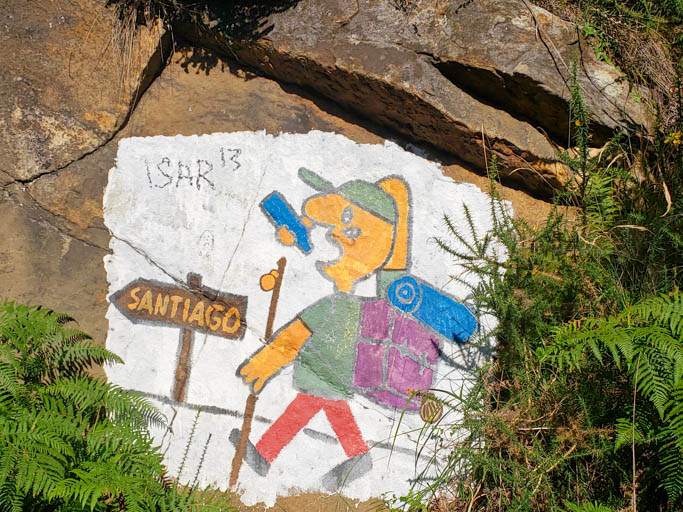
Let’s start with one of the most important packing decisions you can make on the Camino: your choice of backpack.
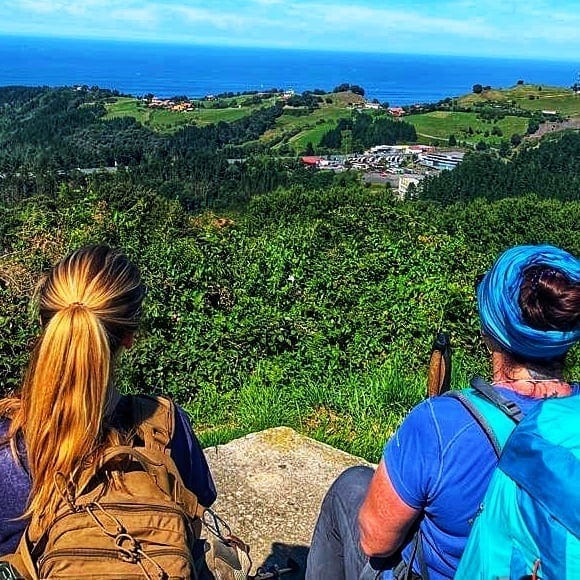
Backpack
do’s and don’ts
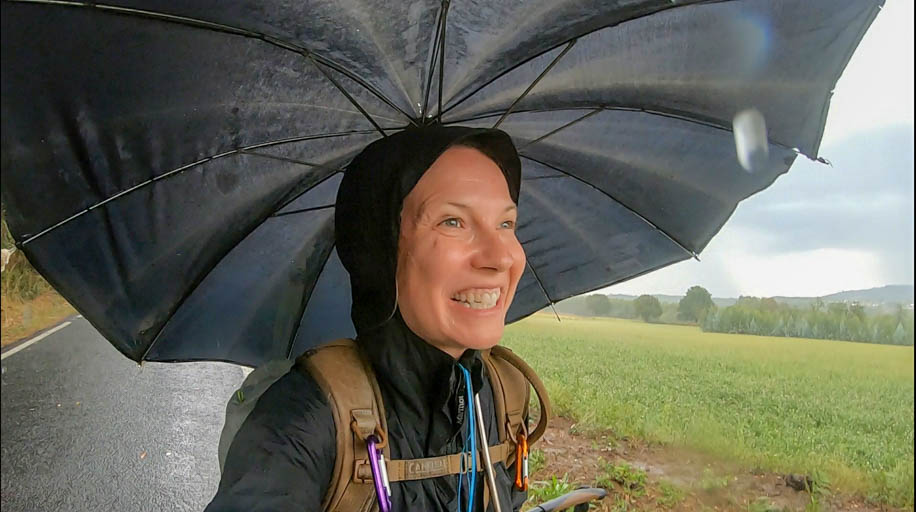
The best Camino de Santiago backpack…
We saw all kinds of bags on the Camino, and Lizz and I both became very attached to the bags that we lived out of for 35 days. But, hands down, we are awarding Lizz’s bag the blue ribbon when walking the Camino de Santiago. She walked with a Deuter Futura hiking backpack.
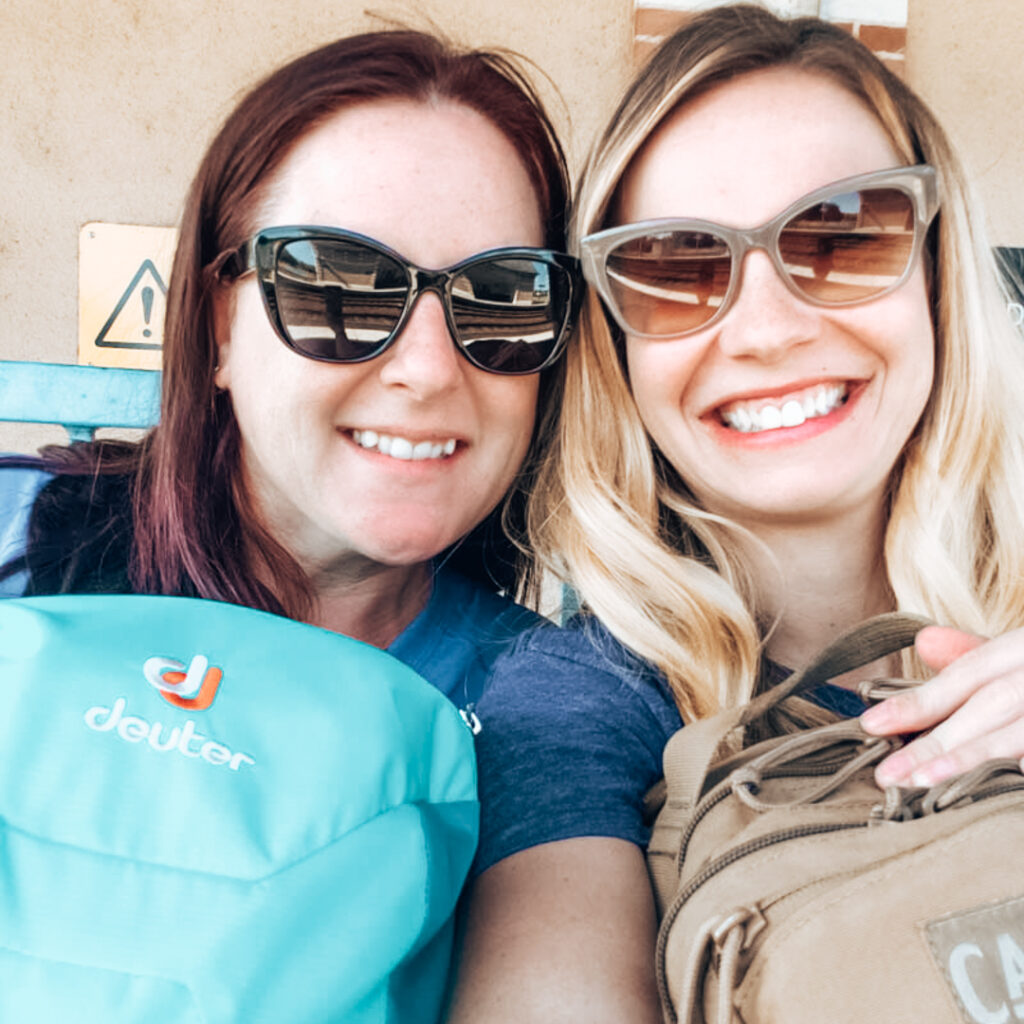
More on her bag below, but first, here’s what I loved and hated about my bag.
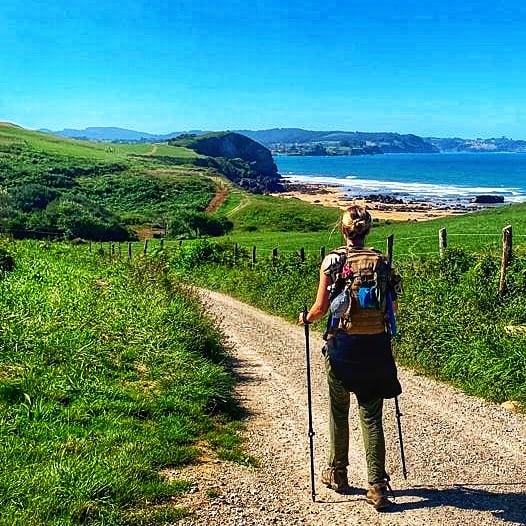
I walked with the CamelBak H.A.W.G Hydration Pack with 100oz (3.0L) Mil-Spec Crux Reservoir.
Pros and cons
to the Camelbak H.A.W.G

Lizz walked with a Deuter Futura hiking backpack. She chose the 28-liter pack in an SL fit for women.
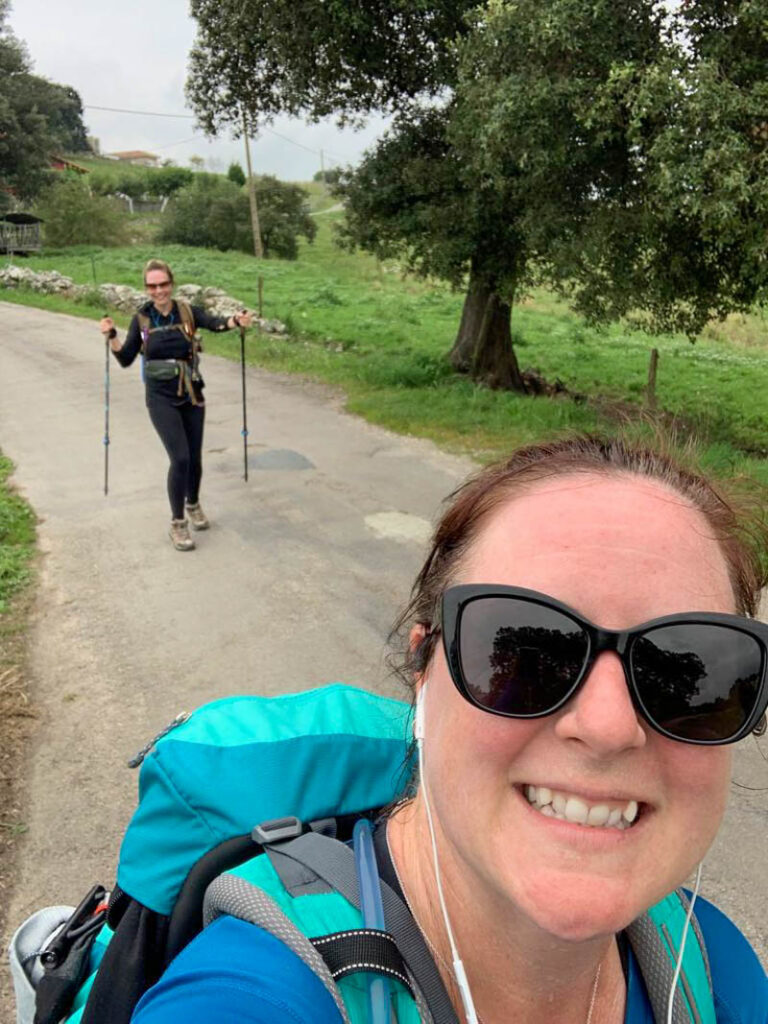
Lizz swears by this bag and, after walking 500 miles with Lizz and that backpack, I completely agree. Here’s what she loved:
A note on water reservoirs or hydration packs: Do you really need three liters? On the Camino del Norte, I did need the full three liters of water twice. And one day I did run out of water. On some stretches of the Norte, there were not that many places to fill up, so I was grateful for the large water reservoir. Most days, I did not fill the reservoir all the way.
On the Camino Frances, I could have easily gotten away with a two-liter hydration pack.
So, it really comes down to which route you are walking. The Frances is well populated with tons of places to refuel. The Norte has less in the way of provisions (but lots of silence and beauty!) No matter what, though, I highly recommend the reservoir system rather than a water bottle in a side pocket. It’s a pain to reach for the water bottle.
To summarize backpacks:
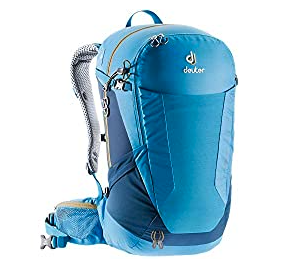
We highly recommend the Deuter Futura Hiking Backpack SL fit for women on the Camino. Here is the exact backpack (28 liters) that Lizz hiked with from REI.
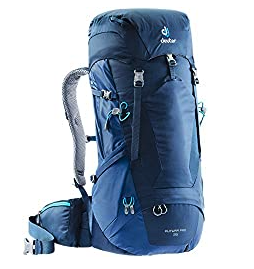
Men may want a larger or wider backpack, like this Deuter Futura 36 Liter backpack or this Deuter Futura backpack from REI. In both cases, purchase a hydration pack sold separately.
This helpful post from Viaje Camino de Santiago dives into choosing the right backpack for you on the Camino, depending on the season that you’re walking and your body type.
Again, it’s super important to get fitted for the right backpack! I was so much happier on my second pilgrimage because I walked with the Deuter Futura Hiking Backpack.
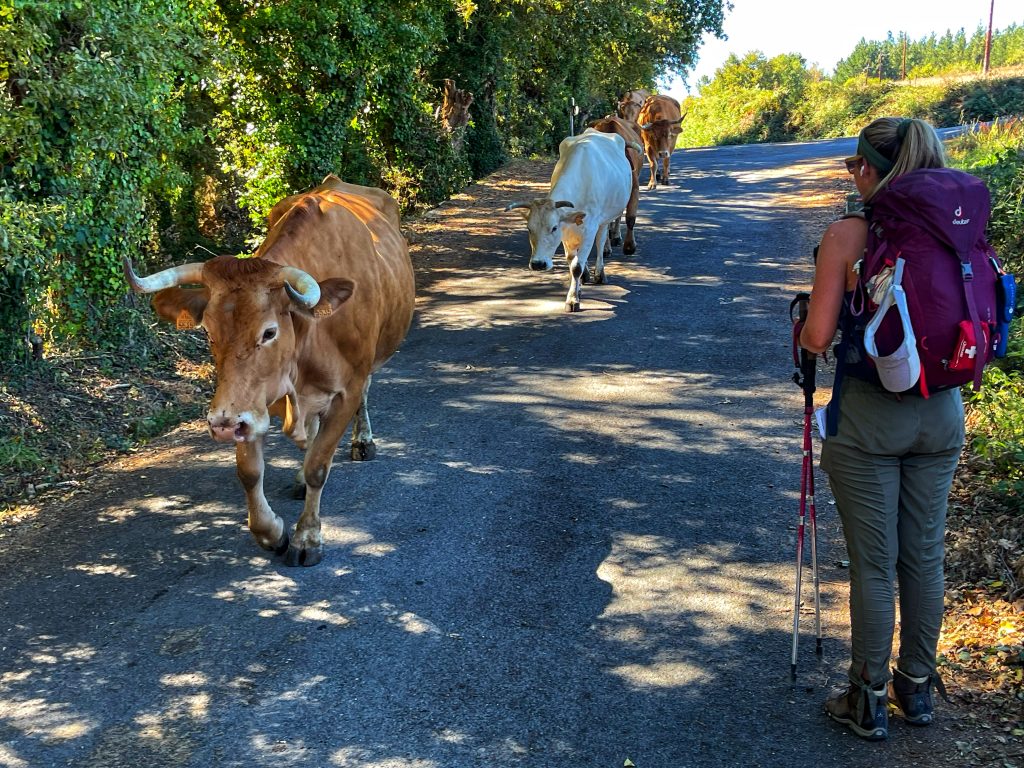
Tip: Bring in a printed copy of my Camino de Santiago packing list when you go to look at bags. The packing list includes the key elements to look for when choosing a backpack.

Do the same when choosing your shoes! Which brings me to…
What kind of shoes should make your Camino de Santiago packing list?
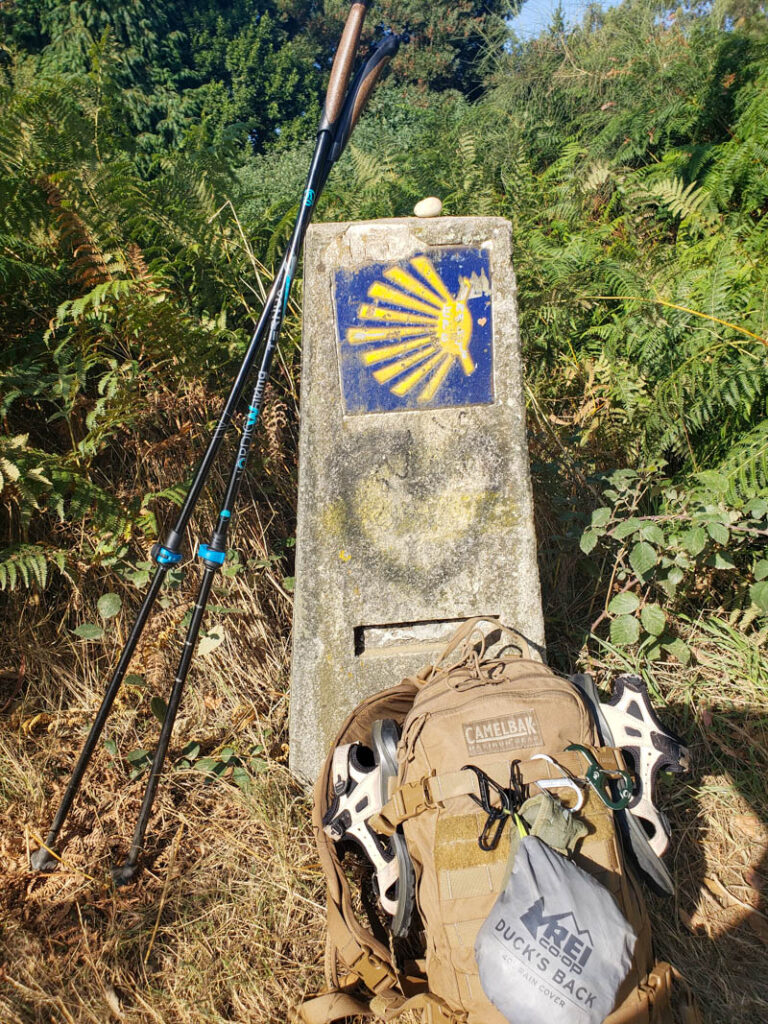
Ohhhhh, the great shoe debate! (This part of my post gets very in-depth, so, if you have already found your shoes, then use the table of contents above to navigate to the next part.)
Many meals are spent on the Camino de Santiago debating shoe and foot-care strategies with other pilgrims. By the time we walked into Santiago, we had definite ideas of what shoes would make our Camino de Santiago packing list for our next pilgrimage. (Spoiler alert: They were not the shoes we packed.)
I’ll be honest, even after two pilgrimages across Spain, I’m still looking for the right shoe solution for my feet. I’ll tell you everything that I know in the hopes that you don’t suffer from blisters the way that I did (twice).
My feet were a particular issue for me on both the Camino del Norte and the Camino Frances. I spent hundreds of euros at pharmacies along The Way:
The shoes we packed on our first Camino pilgrimage (the don’ts):
Lizz did her research and purchased trail runners because the Camino de Santiago often winds through wooded areas, which are perfect conditions for trail shoes. As per usual, I did no research at all but felt pretty confident in my trusty, old waterproof hiking boots.
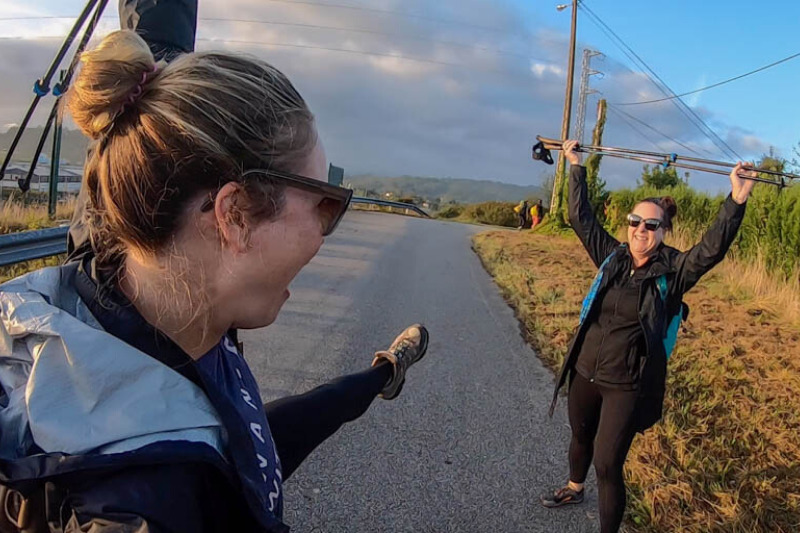
Here’s why we were wrong:
The don’ts when
selecting shoes
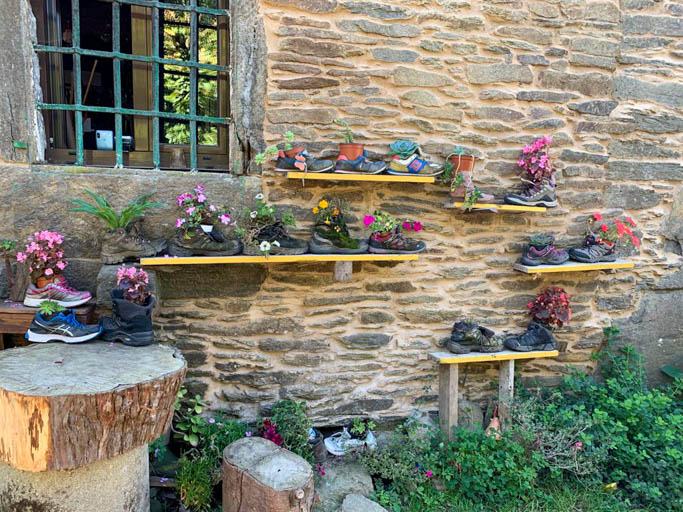
The shoes we will pack on our next Camino pilgrimage (the do’s)
The do’s for shoes:
Note: Every foot has a different need. It’s super important to test your shoes! I skipped the important “step” of testing my shoes on my first pilgrimage, and I really regretted it. Check it out:
It’s also important to consider the time of year that you are walking. Is the risk of rain going to be high? Consider waterproof. Is it going to be hot? Consider opting for something that is more breathable. It’s also important to consider the route that you are walking. Lizz was perfectly comfortable in trail runners during our second pilgrimage on the Camino Frances because there weren’t a lot of days spent on pavement.
Pros and Cons of Waterproof Boots:
When I returned from my first pilgrimage on the Camino del Norte, I went straight to REI and tested a number of different shoes before deciding on the Oboz Mid BDry Hiking Boots.
These are the shoes that I used when I walked my second pilgrimage on the Camino Frances. I love them for day hikes, and I’ll link to the boots here for that reason. (Here are the men’s boots at REI and the day-hiking boots on Amazon for men and on Amazon for women.)
What I loved about the Oboz: The insoles provide great arch support, and the shoes provide great ankle support. They aren’t SO waterproof that ALL moisture (read: sweat) is trapped in your boots and on your feet. They are beautifully breathable but still waterproof. I waded through small streams, and my feet stayed perfectly dry.
What I didn’t love about the Oboz: The same ankle support that I loved meant that the rigid shoes wore on my ankles after many days of walking. I had a bruise and a bit of swelling. Also, the aforementioned blisters started after four days of walking. I can’t blame the shoes for this. It’s my feet. I need to switch shoes every other day or so, or I will get blisters. But that’s the long and short of the Oboz.
Would I wear them again? Yes, but not on the Camino. Shoes that are great for a day hike are not necessarily great for day after day walking. (I learned that lesson the hard way, so that you don’t have to!)
I would try a low hiking shoe from Oboz, like the Sawtooth X Low Waterproof Hiking Shoes:
The advantage here is that the shoe is waterproof and relatively low-weight. The low rise of the shoe should allow you to avoid any uncomfortable pinch around the upper ankle/lower leg after numerous days of walking.
Personally, I like having a waterproof shoe for rainy days because I find walking with wet feet just miserable. The more heavy-duty shoe with ankle and arch support is also good on the Camino del Norte where there are more rocky paths and more stretches of pavement. (The path on the Camino Frances is a bit smoother and there is less pavement, so many people opt for trail runners rather than hiking shoes/boots.)
Here is the Oboz low hiking shoe for men at REI and on Amazon for women and on Amazon for men.
Because I am blister-prone, I will also carry a pair of hiking sandals on my next pilgrimage. This way, I can switch back and forth between the hiking shoes and the sandals, relieving any hot spots that are starting to form. I will try something like the Keen Newport H2 or the Teva Terra Universal Sandal. (I am currently trying the Keen Newport H2 and will update this post if I love them!)
The Teva sandal gets rave reviews, has excellent arch support, and its lightweight means that it won’t add that much to your pack. The velcro straps make the sandal easy to attach to the back of your backpack. Teva Terra for men. And from Amazon for women and for men.
Since the Teva Terra sandals dry quickly, these would double as my shower shoes when needed. (Occasionally, you will find a communal shower that needs a good cleaning.) If you choose to walk with just one pair of shoes (as you should do if you are not blister-prone like me), then consider a pair of cheap, foldable flip-flops for shower shoes. Better yet, spring for the Olukai Ohana flip-flops recovery flip-flops to “hug” your feet at night!
Pros and Cons of trail runners
Over dinner at the end of your day on the Camino, you will read ahead about the next day’s Camino stage. That’s when you’ll find out whether you’re in for a day of pavement or trails. If you’ve got a trail day ahead of you, you’ll be happy if you have a pair of Altra Trail Running shoes like the ones Lizz wore. Here they are at Amazon.
Here’s the men’s version of the Altra Trail Running Shoes at REI. And at Amazon.
Lizz loved her Altras on the Camino, and she never got a blister, but she needed something with more arch support for pavement days. (There are more pavement days on the Norte than on the Frances.) She also had a couple of rough days when it rained and her feet were soaking wet.
On the other hand, while my boots protected my feet on pavement and in the rain, I needed a pair of more lightweight, breathable shoes for trail days and for hot days when my feet were throbbing from their numerous sweat-induced blisters.
That’s why they call it the great shoe debate! The right answer for my feet might be completely different than the right answer for your feet. So weigh the pros and cons, consider the route and the likely weather, test the shoes at an outdoor store, break them in before you go, and don’t be afraid to go back to the store and try again if you feel hot spots or any discomfort as you are breaking your shoes in. Trust me, it’s better than buying new shoes when you’re on the trail (I did that on my second pilgrimage, and guess what – I just got blisters in different places from wearing new shoes)!
In summary, the shoe solution for me on my next pilgrimage will be a pair of low-rise, waterproof hiking shoes AND a pair of hiking sandals strapped to the back of my backpack. I will switch shoes when my feet start to hurt and wear waterproof shoes in the rain. Lizzie will stick with her trail runners as long as she isn’t walking a route with a lot of pavement. She isn’t blister-prone, so she doesn’t need to switch shoes, and she isn’t that bothered by walking with wet feet if it rains. She does carry a pair of shoes for evenings and showers (keep reading to see her second pair of shoes).
Here are some other shoes that I will consider:
I am currently testing the Salomon X Ultra Gore-Tex Low Hiking Shoes. The low-rise style still provides the ankle support I like, so I don’t need the mid-rise style I wore on my second pilgrimage (which caused the area above my ankles to swell). I am very comfortable in the shoes, but I can already tell that they will be too hot for walking in the summer months.
I really like Salomon’s “quicklace” shoe lace solution, so that I’m not bothered with shoes that untie while I’m walking. This was a huge hassle for me on my first pilgrimage. On the second pilgrimage, I replaced the standard shoe laces that came with my shoes with a quicklace system like this:
I’m also trying the Vivobarefoot Tracker Low. So far, so good. These shoes are “barefoot shoes,” so they are minimalist and meant to mimic a barefoot experience. For this reason, they don’t offer the same support as a hiking shoe/boot, but they do provide some support and a lot of traction. They are lightweight and they breathe well, even though they are water-resistant. They take a while to get used to because the barefoot style means that the feet need to be stronger as they aren’t relying on the shoe structure for support. Right now, I really like them, but I can’t, yet, walk long distances in them. I’ll keep you posted!
Do consider a pair of shower shoes
If you are squeamish about communal showers, then you’ll probably want a pair of shower shoes. On the Norte, I bought a cheap pair of flip-flops and strapped them to whatever shoes I wasn’t wearing.
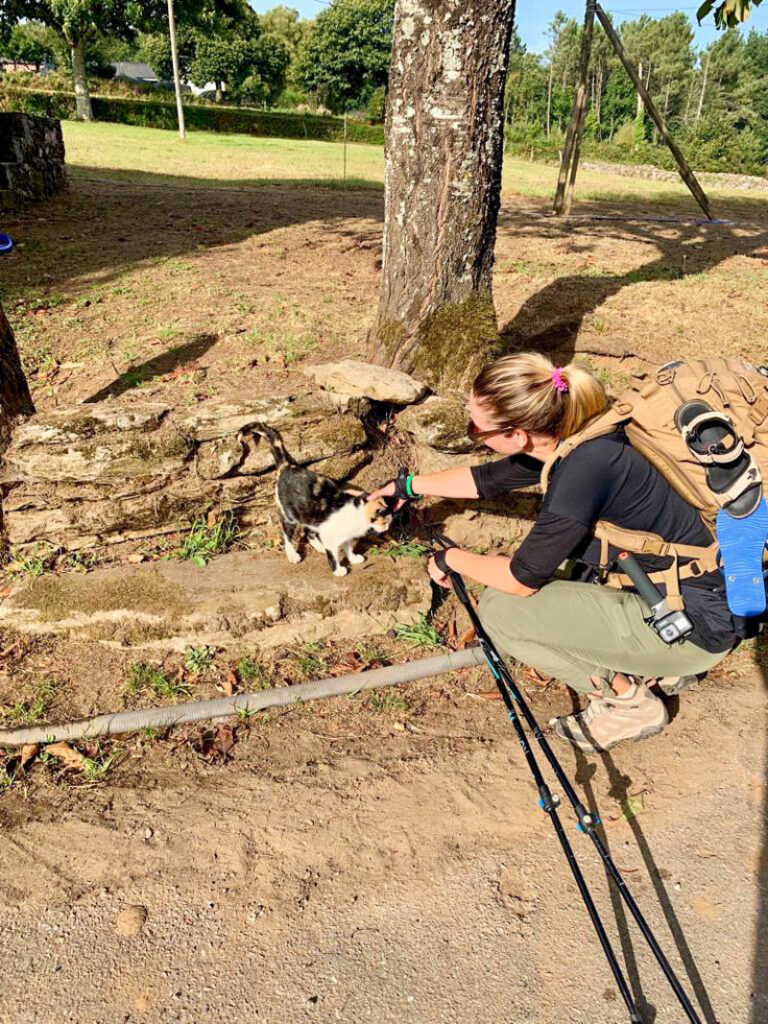
I didn’t carry shower shoes on the Frances, where I found bathroom conditions to be a bit better (or maybe I just got less squeamish the more I walked!)
When selecting your shower shoes, remember that you might end up wearing these at night. Your feet will want a break from any kind of “real” shoes, and they’ll love the time spent without socks/shoes while you’re relaxing with a glass of wine after a day of walking.
Lizz wore the Skechers sandals below both at night and in the shower. They dried quickly and gave her feet both the break they needed and the arch support they required. (Skechers sandals for women/Skechers sandals for men.)
These shoes are a little heavier and require more space than a throwaway pair of flip-flops, so keep that in mind. BUT Lizzie loved the way they “hugged” her feet at night and gave her a much-needed reprieve from her walking shoes.
If I were carrying only one pair of shoes, then I would bring a pair of “recovery sandals” that would double as my shower shoes. These are slip-on sandals that are designed to bring comfort to your feet after running or hiking. The Olukai Ohana flip-flops are my go-to recovery sandals:
Here are the men’s Ohana sandals from REI and the women’s Ohana sandals from REI.
RELATED POST
SOCKS! A crucial item on your Camino de Santiago packing list
I believe socks belong right at the top of your Camino de Santiago packing list.
To avoid blisters, it’s crucial to have dry socks on your feet. This is one of those lessons that I learned the hard way. By the end of our pilgrimage, I would swap my socks nearly every time we took a rest, putting them on the back of my bag to dry while I walked.
Seriously, socks were so important to me on the Camino that I started hoarding them! When we would go into a big town, I would stop at the outdoor store and stock up, sticking them into every available inch of space in my bag and pockets.
The good news is that I tested SO MANY pairs of socks that I now know the exact socks that you should carry so that you don’t have to become a sock hoarder like me. (I earned the nickname the Queen of Socks for a reason!)
How many pairs of socks and what kind to pack?
take it from the queen of socks:
After trying ALL the socks, the Wrightsock brand is the winner for me. The Wrightsock anti-blister system works because of the double layer. The two layers of the sock rub against each other instead of your skin! And, though there are two layers, I found the cool mesh to be breathable and lightweight, and I did not suffer any slipping or bunching.

I swear by the Wrightsock! Get your Wrightsocks here from Amazon or here from REI. I preferred the cool mesh quarter-length socks, but they do have shorter socks and longer crew socks as well.
The one disadvantage that I found with the Wrightsock is that they aren’t as durable as other socks. I finally found these socks halfway through my second pilgrimage, and I had worn holes into the upper layer of the sock by the time I reached Galicia. So you might need to buy new pairs of Wrightsocks at an outdoor store along the route. (For me, it was well worth the stop to avoid the blisters!)
Here is the exact Wrightsock that I wore (with Camino shells!):
Do you really need three pairs? You might be able to get away with two. I will walk with three pairs on my next Camino because I like to switch my socks every time I stop to keep my blister-prone feet dry and happy. Walking with three pairs means that I always have at least one pair that is dry and (relatively) clean.
Round out your sock supply with one pair of Merino Wool Hiking Socks (long) for cooler days and for the evenings. I carried the same pair of Merino socks on both of my pilgrimages, so these are super durable socks. You won’t need to replace these socks along the route! They are also really nice on cool evenings.

Other socks to consider on the Camino
If you aren’t sold on the Wrightsocks or you just have your favorite brand, then wear what works for you. I tried (and liked) Darn Tough socks and injinji toe socks (see below), but I still got blisters until I switched to Wrightsocks.
If you do not wear Wrightsocks, please do consider silk sock liners. This will provide that double layer that you get with the Wrightsocks.
I found silk sock liners halfway through my first pilgrimage when a sympathetic pilgrim gifted me one of her pairs. At that point, the blisters on my toes finally began to heal because my socks rubbed against the liners instead of my skin. I paid it forward once I found the Wrightsocks on my second pilgrimage, and I gave away my precious silk liners to another pilgrim who was suffering from blisters.
Because I had so much trouble with blisters in between my toes, I may also bring toe socks with me in case I need to relieve my toes from blisters.
You can also consider pairing the injinji toe-sock liners beneath a hiking sock like the Merino Wool Crew socks discussed above or the injinji Hiker Socks.
But with two to three pairs of Wrightsocks and one pair of Merino Wool Socks, you should be able to avoid turning into a sock hoarder like I was on my first two pilgrimages:
The Camino clothing do’s and don’ts
First things first, throw fashion right out the window. One day Lizz took a picture of me so we could laugh later at how I went from fashionista to, well, not even close. This is what she got:
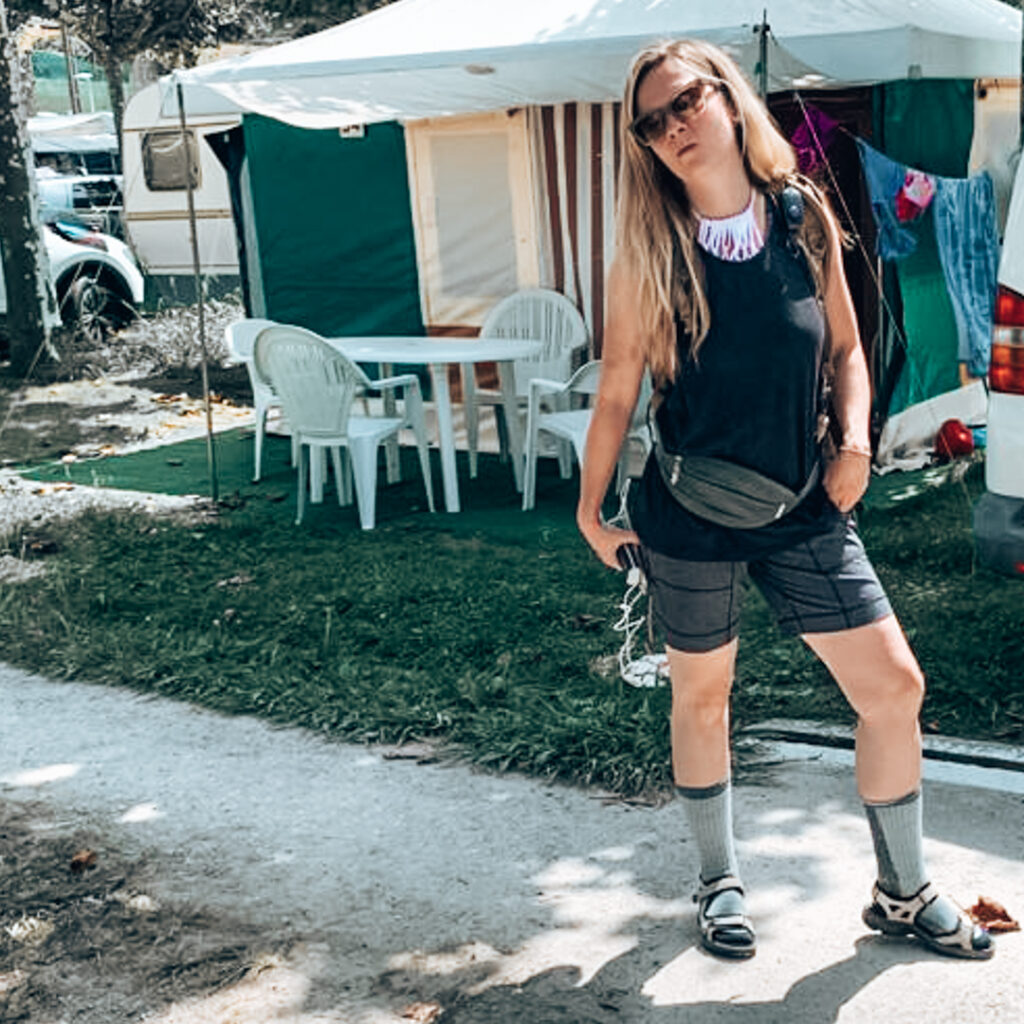
In my defense, all of my clothes were in the wash, and that glow-in-the-dark hip bag was one of the most important things I packed since it served as my wallet. I needed to keep my feet dry at all times, hence the socks and sandals.
But, yeah. Fashion. Out. The. Window.
clothing
DO’S AND DON’TS
RELATED POST
The essential clothing items for your Camino de Santiago packing list
One lightweight rain shell with hood
You want this to be lightweight so that it will roll up really small, and you want it to have zips in the armpits (pit zips!) because it’s super warm in that shell even when it’s raining.
Being from the rainy Pacific Northwest, I got the jacket thing right on the Camino. This is the Marmot rain shell I wore and loved. Here is the Marmot men’s rain shell. And here is the Marmot women’s rain shell from Amazon, and here is the men’s version from Amazon.
Here’s that rain shell in action:
I opted to take a cooler rain shell on my second pilgrimage because I was walking the warmer Frances route (rather than the cooler coastal route), and I walked in August. Here’s The North Face rain shell that I carried from Amazon and from REI. Here is the rain jacket available directly from The North Face. This rain shell worked beautifully! It was super lightweight, and I loved that it rolled up nice and small and fit into a pocket.
Here’s that lightweight rain shell for men from The North Face, and here is the men’s rain jacket on Amazon and from REI.
One warm, packable fleece or puffy jacket for cool days & nights
We walked our first Camino in August and September, so we were prepared for extreme heat. But on the coastal route, most of the time, we needed our jackets in the mornings and the evenings. I didn’t use my jacket as much on the Camino Frances in August, but on the occasions when I needed it, I was sure glad to have it.
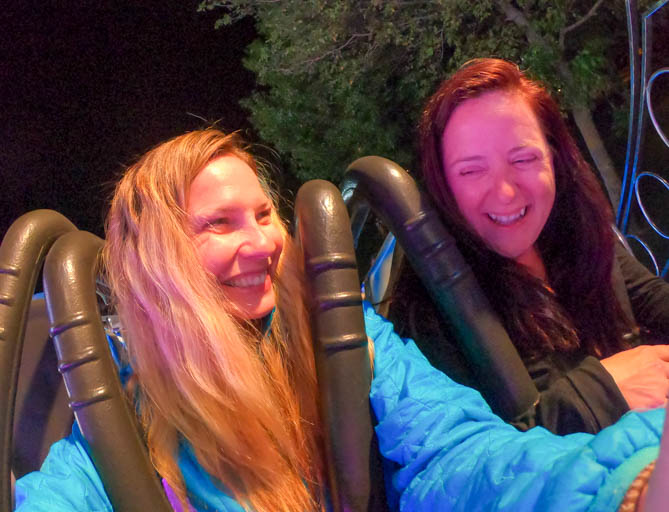
The puffy jacket that I wore is no longer in production, but that’s because there are way better jackets on the market now. Like the Patagonia Nano Puff® jackets. Warm, windproof, and water-resistant, this jacket is made from post-consumer recycled polyester, it’s fair-trade certified, AND it packs into a tiny pouch. Here is the Nano Puff for men.
One long-sleeved, lightweight pullover or zip-up hoodie
Most mornings, I wore a super lightweight pullover that dried really fast. Much like this moisture-wicking, sun-shielding hoodie. Here is the men’s moisture-wicking hoodie.
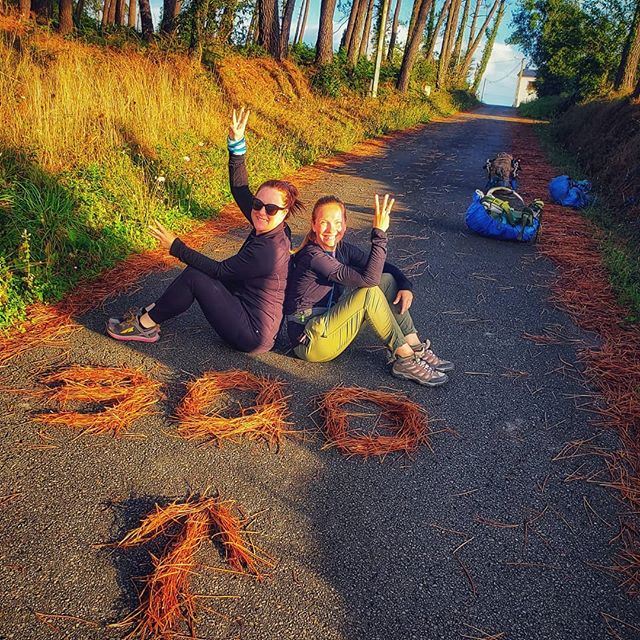
Two pairs of quick-dry pants (and possibly one pair of shorts/skorts)
On my first Camino, I packed one pair of quick-drying hiking pants and one pair of long yoga pants. I lived in the quick-dry hiking pants because the yoga pants took too long to dry after washing. I also packed a pair of shorts, but I preferred walking in lightweight long pants for sun protection and for branch/thorn protection on wooded trails.
On my second pilgrimage, I packed the same quick-dry hiking pants that I loved from the first pilgrimage (and I still loved them). I ditched the slow-to-dry yoga pants and brought a second pair of calf-length, quick-dry pants, prioritizing pockets because the lack of quality pockets was the one thing I disliked about my favorite pants.
The plan for the third pilgrimage is to bring two pairs of quick-dry pants and one hiking skort that I will mostly wear at night but can also wear while walking.
Bottoms for your Camino Packing List (ladies)
1 pair of quick-dry pants
These pRana Wonderland Rock E-Waist Joggers are very close to the same pants that I wore and loved on both of my pilgrimages. Thankfully, they have improved the pockets and these pants boast both hand pockets and size-zipper pockets. Plus they are quick-dry, moisture-wicking, water-repellant AND they offer UPF 50+ sun protection. Here are the pants directly from pRana. I would definitely pack one pair of these.
Second pair of quick-dry pants
The KUHL Trekr Straight Pants are quick-dry and stretchy. They offer sun protection and both thigh pockets and back pockets. Here are the pants directly from KUHL. You might also want to check out the KUHL Freeflex Zip-Off pants. The ability to switch to shorts is really great for anyone who prefers hiking in shorts. Just beware of any extra seams or zippers if you are a chafer. Here they are direclty from KUHL.
1 Hiking Skort
The Free Fly Active Breeze Skort is quick-dry and comfortable and it has pockets tucked into the soft short liners! Here is the skort from Amazon.
Other options
If you want the option for a capri-length pant, the KUHL Trekr pant cinches up when you don’t need the long length. I really like this option and might opt for these as my second pair of pants even though they are not technically quick-dry. (They do however dry quickly as they are made from polyester and nylon.) Here they are directly from KUHL.
Can’t imagine hiking in anything but shorts? Try the quick-dry, water-repellant Terrebonne Trail Shorts from Patagonia. Personally, I would stick with pants in case you end up in the sticker bushes (it happens!) and to protect against the sun, but if you are most comfortable in shorts, then these are a great, lightweight option. You can also consider carrying two pants and a pair of shorts, but remember that you want to keep your bag as light as possible. I would do this only if the shorts were going to be my nighttime outfit. (See more on nighttime outfits below.)
The Patagonia Tech Skort is substantially longer (18 inches) than the short skort (13 inches) listed above. If you like extra length but want to keep all the functions of a quick-dry skort with loads of pockets (three!), then the Patagonia Tech Skort is a great option.
Bonus: The liners boast odor control materials so you can get away with a couple of extra wears without washing.
Bottoms for your Camino Packing List (men)
Quick-dry pants
The men on the Camino really liked convertible pants (they switch from pants to shorts with a quick unzip). For a pair of hightly rated, quick-dry convertible pants, try REI Co-op’s Sahara Convertible pants. Breathable with six pockets and the ability to convert to shorts or to unzip vertically from ankle to mid-thigh, these pants are very versatile.
Second pair of quick-dry pants
The Renegade Recon Pants from KUHL score points for comfort. They are breathable, stretchy, and abrasion resistant. Here are the pants directly from KUHL. The Trail Sender Pants from Mountain Hardware are extremely lightweight and reviewers say they are like wearing silk pajamas on the trail. Here the Trail Senders from Amazon.
1 pair of shorts
Chubbie’s Everywhere Shorts get rave reviews for comfort and being just the right length. Quick-dry and water-resistant with antimicrodial properties, you can get away with washing these a little less often (a major bonus on the Camino). The shorts could double as your pajama shorts. Here are the Chubbie’s shorts from Amazon.
If you liked the sound of the comfortable Train Sender pants above, Mountain Hardware also makes Trail Sender Hiking Shorts. These could also double as your nighttime pajama shorts. Here are the shorts from Amazon.
Two or three quick-dry, moisture-wicking shirts
I brought two tank tops on my first pilgrimage, and I wish I had brought one tank top and one t-shirt. (I ended up wearing my nighttime t-shirt quite a bit out on the trail.)
On my second pilgrimage, I carried the tank top and hiking tee listed below, and I would do that again. I also carried a third shirt: a crop top with a built-in bra that I wore frequently. I would bring the same combination of shirts on my third pilgrimage. All of these shirts work well for hiking and nighttime wear/pajamas.
For women
Here’s what I carried on pilgrimage number two – and I would do it again: One Patagonia Capilene Cool Daily Shirt and one Patagonia Capilene Cool Daily Tank Top.
The base layer is pretty important. You want it to be moisture-wicking and soft. The Capilene Cool Daily shirts are made to feel like cotton, but they are made with moisture-wicking, odor-controlling polyester. There are no itchy tags at the neck, and they have a locker loop for easy drying. This is key because it can be hard to find places to hang your drying clothes at some of the albergues (pilgrim hostels) where you will stay on the trail.
I also brought this lightweight crop top from Beyond Yoga. Quick-dry with a built-in bra, it was a good addition to my Camino wardrobe both on the trail and at night. Here is the crop top from Amazon.
Crop tops and built-in bras might not be for you, so if you choose to bring an optional third shirt, make sure it is one that you can wear for hiking, sleeping, and sitting in a restaurant at night.
For men:
I would bring two different colors of the Patagonia Capilene Cool Daily Shirt and consider one sleeveless option of the Patagonia Capilene style.
This moisture-wicking shirt contains odor-controlling properties, and the soft fabric and minimal stitching reduce chafing.
Nighttime/sleeping clothes
I would choose hiking clothes that you are comfortable sleeping in and that you can wear out to a restaurant. In the above list of clothing options, I would mostly wear my skort and crop top at night with the lightweight hoodie or packable puffy jacket. For sleeping, I would wear whatever is clean. There is absolutely no shame in sleeping in what you plan to wear the next day.
Remember that you will be staying in pilgrim hostels (albergues) that often have communal, co-ed sleeping arrangements with bunk beds. You’ll want to wear pajamas even if you don’t usually do so at home.
Underwear for your Camino de Santiago packing list
For women:
Bring two to three pairs of quick-dry, hiking underwear. I brought two pairs and this worked just fine because we did laundry nearly every day. On a day when we didn’t do laundry, I hand-washed my underwear.
In your daily life, if you usually wear thongs, then I recommend bringing thongs for the Camino, too. I usually wear thongs and switched to a bikini-style on my first pilgrimage, and this drove me insane. I switched back to thongs on my second pilgrimage, and I was much more comfortable.
I wore Merino Thong Underwear from the REI Co-op, and I am still wearing the same pairs of underwear to this day.
They are super durable, comfortable, and odor-resistant. Plus, with less fabric, the thong is going to dry faster and be a bit less obvious hanging from the back of your backpack!
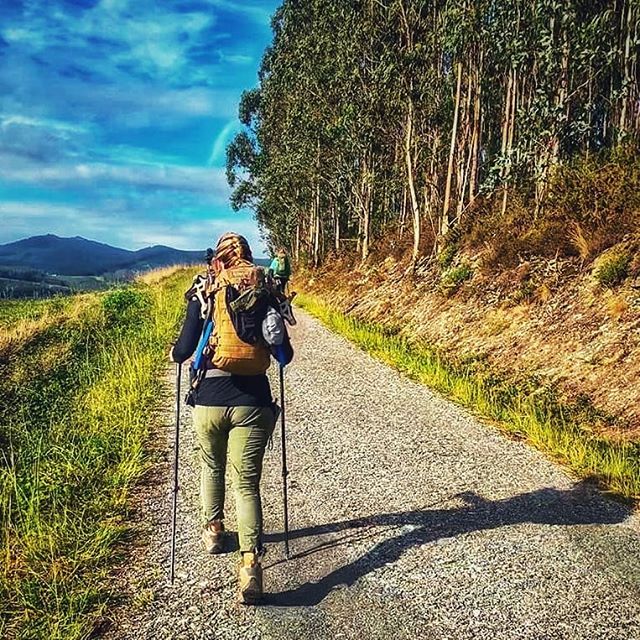
On the flip side, if you usually wear bikini-style underwear, then don’t switch to a thong for the Camino. The Smartwool Intraknit Bikini Underwear will still dry fast, and this underwear is made with smooth stitching to reduce the risk of chafing. Here they are from Amazon.
The same logic holds true for the two sports bras you should put on your Camino de Santiago packing list. If you usually wear a certain kind of sports bra, this isn’t the time to switch it up.
On my first pilgrimage, I brought two sports bras, one with thin straps, one with thick straps, and one tank top with a built-in bra. The tank with a built-in bra took too long to dry, and the bra with the thick straps competed for space on my shoulders with my backpack straps.
The winner was the thin-strapped sports bra. I brought two of the same thin-strapped sports bras on my second pilgrimage, along with a quick-dry tank with a built-in sports bra. I was much happier with this arrangement.
Check out the Smartwool Intraknit bras. There are no adjusting clips on the straps that will promote chafing, and the Smartwool is comfortable and odor-resistant. A TENCEL lyocell layer promotes fast drying. Here is the Smartwool Intraknit Strappy bra from Amazon.
For men:
The key is to find quick-drying, moisture-wicking underwear that is close to the style that you are used to wearing. If you are comfortable hiking in boxer briefs, don’t suddenly switch to briefs for the Camino.
Here are a few pairs of men’s underwear with the right quick-drying, moisture-wicking, chafe-resisting qualities that you want:
You’ll want to pack two or three pairs of underwear. I brought just two, and it worked well for me, but I did wash my underwear in the sink a few times.
A hat or buff is a must for your Camino de Santiago packing list
I say they are a must, but I admit that I didn’t wear either on my first pilgrimage. A hat is a really good way to protect yourself from the sun, and if I wore one, I may have been able to skip the extra face lotion with sunblock that I had to carry. Hats just drive me nuts because of my thick hair, but most people do carry a hat.
Lizz likes the REI packable cap. You can pack it up small, and it’s moisture-wicking with ventilation and a sweatband.


The North Face Horizon Breeze Brimmer hat comes highly rated for its moisture-wicking sweatband and it earned a seal of recommendation from the Skin Cancer Foundation. Here is the hat from Amazon.

I did carry a buff on my second pilgrimage, and I wore it when I was really sweaty or to ward against bugs. Lizz carried two and wore one almost every day, either around her neck or on her head, to protect against the sun and dripping sweat.
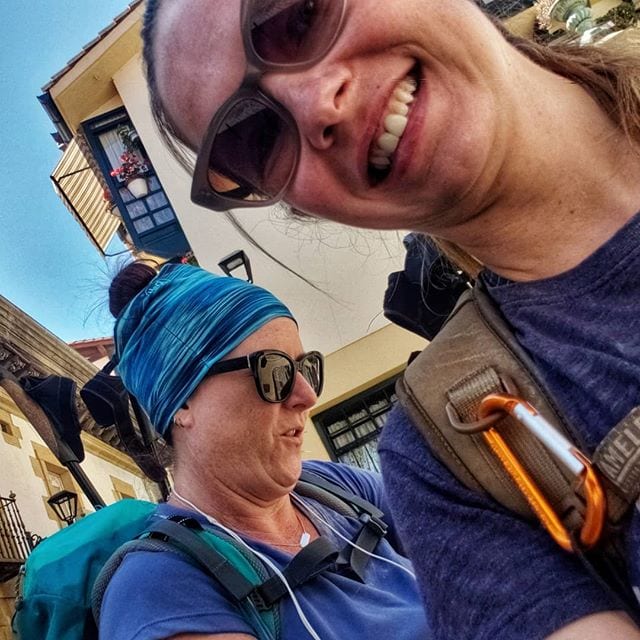
I like the Buff Original Multifunctional Headwear, made with a quick-drying polyester that shields against sun rays. (It’s also made with recycled materials, which helps me with my crusade against plastic water bottles!) There are a lot of outdoor stores in major cities along the Camino de Santiago where you can purchase a buff (or two) with Camino shells or arrows.
Should you add a swimsuit to your Camino de Santiago packing list?
If you are walking a route that traces the coastline (like the Camino del Norte route), then you should consider it. We loved jumping into the water after a long day of hiking, especially after day one on the Camino:
But I’m not sure that we jumped in the water enough to justify carrying a swimsuit. Ladies, if you carry a pair of shorts or skort, you can just go in the water with that and your sports bra. That is exactly what Lizz and I did at the end of our second pilgrimage when we jumped into the Atlantic at the “end of the Earth” in Finisterre.
Guys, if you carry a pair of hiking shorts, just wear those when you dive in the water.
Should you bring something special to wear in the evenings on the Camino?
It’s a luxury and definitely optional. You can always just wear whatever is clean in your backpack. On both of my pilgrimages, I brought a sporty nighttime dress, and I loved getting out of hiking clothes. I brought this sporty dress from Beyond Yoga on my second pilgrimage.
The drawback was that I couldn’t hike in that dress. So, on my third pilgrimage, I’ll wear a skort at night that I can hike in and one of my hiking shirts. If I were to bring a dress, I would probably opt for the prAna Railay Pocket dress. It is wrinkle-resistant and packs up small. In a pinch, I think you could wear it on the trail as well.
Guys, if you want a separate nighttime outfit, then I suggest bringing a special t-shirt from home and pairing it with your cleanest pair of hiking bottoms.
Essential documents for your Camino de Santiago packing list
- Passport
- You will be asked to present your passport and your pilgrim credentials (see below) at every albergue, hostel, or hotel that you stop in along the route.
- Credentials
- You must have Camino de Santiago credentials – also called Camino passport – to stay in the albergues (pilgrim hostels) along the route. Only pilgrims can stay in these hostels and the credential is your proof that you are a pilgrim. You collect stamps in your credentials at the albergues (or at cafes, hotels, and churches) along the route. The stamped passport is what you present in Santiago to earn your Compostella, which is the certificate that proclaims that you walked all the way to Santiago de Compostella.
- Purchase your credentials at a pilgrims’ office when you get to Spain. Sometimes they are also available at the tourist office and even at some albergues. You can order in advance from your country’s Camino association as well. But it’s not really necessary. (Americans visit here to order in advance.)
Essential items for your Camino de Santiago packing list
- Hiking sticks/trekking poles:
- Some people don’t like walking with hiking sticks, but this was not an option for Lizz or for me. We walked the first day of our first pilgrimage without sticks and then immediately visited an outdoor store that very evening to buy sticks. This took so much pressure off our backs and legs and allowed us to walk much faster. In fact, there was almost an international incident on the Camino when someone stole our sticks! There are a lot of sticks on the market. Look for lightweight and, personally, I liked hiking sticks that folded so that I could stick them in a side pocket of my backpack when I wasn’t using them. If you are not checking a bag to travel to Spain, consider buying your sticks when you arrive.
- Fast-drying towel:
- You will use your own towel in the albergues (pilgrim hostels) on the Camino, so you must have one that folds up small and dries fast.
- Sunscreen
- The link above is lightweight sun cream in recyclable, renewable sugarcane packaging. The reality is that you’ll probably buy your sunscreen after you travel to your first stage. Keep an eye out for sustainable sunscreen, but the priority on the Camino is that your sunscreen will fit in an accessible pocket for easy grabbing.
- Contact lenses/glasses
- I wear daily disposable contact lenses, which would be bulky and cumbersome to carry on the Camino. My solution was to wear prescription sunglasses during the day and my glasses in the evening.
- Sunglasses
- The link above is for bamboo sunglasses, so that if (when) you lose them, no plastic will end up in Spanish landfills.
- Silk Sleep Sack
- I didn’t have this when I first set out, and that was a huge mistake. Especially since we ended up in a freezing-cold hostel on our second night on the Camino. I wore every item of clothing in my bag and snagged a tablecloth for a blanket! The sleep liner is a must at hostels and albergues where blankets and sheets are not guaranteed. It protects against bed bugs as well as dirty sheets, blankets, and pillowcases. I liked the option with the pillow sleeve so that my head rested on something clean and soft.
- Trek and Travel Laundry Wash
- This tiny container holds 50 laundry leaves. It doesn’t take up much space in your bag, and you’ll be grateful for it every time you throw your clothes in the washing machine.
- Tweezers
- Nail Clippers
- Fork and knife multi-tool device (fork, knife, spoon, bottle opener, can opener, wrench)
- We used this all of the time. It was lightweight and came in a bag that attached to the outside of our backpacks. I was so sad when I had to leave it behind in Spain because I couldn’t carry it on the airplane.
- Carabiners
- You can’t have enough of these! Hook them onto your bag before you go. You’ll be amazed at how many different items hang off of them by the end of your pilgrimage.
Essentials for women
- Diva Cup
- Super lightweight and sustainable solution for your menstrual cycle.
- Kula Cloth (for anyone who squats when they pee)
- This is an antimicrobial, absorbent, anti-odor pee cloth. Think of it like your sustainable toilet paper so that you can leave no trace out there on the trail. You will be popping a squat out there. You may as well do it sustainably. This means that you don’t have to carry toilet paper. And since the Kula Cloth snaps to the outside of your bag (don’t worry, it folds up for privacy reasons and sanitary concerns), it takes up no space in your bag. Throw it in the washing machine or hand wash. Good for multiple uses. This is a game-changer.
And Kula Cloth now has a Camino design!
Optional items to consider
Carefully consider weight and space when deciding whether you need these items. We did carry most of these items in our backpacks, though we split them up between us to distribute the weight. The last item was especially crucial for our first pilgrimage on the Norte!
- Water purification tablets
- Super light and perfect for cleaning tap water. We put these in our backpack water filtration system every time we filled them up in a bathroom sink (which was often on the Norte). I didn’t use them very often on the Frances, where water supplies were more reliable.
- Packing cubes
- It’s super important to keep everything organized in your bag, and packing cubes helped me do that while maximizing space.
- Anti Monkey Butt Powder (for men) & Anti Monkey Butt Power (for women)
- Is chafing a problem for you? You might want to bring some anti-chafing powder. Tip: It’s hard to find anti-chafing powder once you get to Spain.
- Headlamp
- A headlamp is always good to have in your backpack, just in case, but on the Camino, you will mostly need a light when all the lights are out at the albergue and you need to get into your bag or bunk without waking everyone up. For this, your phone flashlight should do the trick.
- Travel cable and lock
- Pilgrims don’t usually steal, but it’s better safe than sorry when you’re traveling anywhere. If you are carrying electronic equipment like I did for my blog/vlog, then a cable and lock are a really good idea. If you aren’t leaving a lot of valuables in your backpack, then you can skip this (unless it will help your peace of mind to lock your bag up).
- Earplugs
- If noises keep you up at night, then you’ll want to bring earplugs. There is a lot of snoring in the communal sleeping rooms in albergues, and, if you’re walking during the summer months, there are a lot of all-night festivals in Spain with loud music.
- Emergency whistle
- Keep this on a carabiner in a very easy-to-reach place on your backpack strap. I started out with one of those emergency alert alarms with a button, but I switched to a whistle after I accidentally set it off in a crowded train car on our way to our Camino starting point. You’ll actually hear those wearable alarms going off all the time on the Camino and, unfortunately, they get ignored because my experience on the train is pretty common. Carry a whistle instead.
- Hip bag/waist pack
- Or, as they say in America, a fanny pack. We wore these every day to store our passport, Camino credentials, ATM card, and cash. It was our wallet. We also stored a backup credit card in our backpacks with a small amount of cash. If you have hip pockets on your backpack, then you can store your essentials there, but I found it was still convenient to have the hip bag at night and even during the day, when I would shrug out of my backpack and collapse into a cafe chair.
- Guidebook
- If you like to feel pages in your hand, then tear out the pages of the guidebook specific to your route and carry those. I carried a Kindle with my guidebook, but I wouldn’t do that again. Instead, I will download the guidebook to my phone (and listen to regular books on Audible). Also, make sure to download the Buen Camino App to help plan your next stage and find accommodations.
- Wine opener
- This was an essential item for Lizz and me, but skip it if wine at night isn’t your thing.
- Journal and pen
- I have a refillable journal, and I carried one of the notebook inserts, leaving the leather binding behind.
- Massage roller
- I was torn on where to put this. I almost put it in essential items. Lizz and I used our roller every day. Me for my sore back and Lizz for her sore feet. One time, I misplaced the roller and there was this horrible five-minute period when we couldn’t find it. Oh, the look on Lizz’s face. I thought we were going to have a murder on the Camino!
- Wilderness Wipes
- When a shower isn’t possible, wilderness wipes will do the trick. Plus they are compostable.
- Collapsible bowl and collapsible cup
- I used both the plate and cup quite a bit for impromptu picnics both on the trail and at night, but this is definitely a luxury item. Only carry if you think you’ll use them a lot.
- Sleeping bag
- The great sleeping bag debate! I have had a number of comments and emails stating that every Camino packing list should include a sleeping bag. I didn’t bring one on either pilgrimage, but that’s because I knew that I would splurge on a hotel if albergues were too full. Also, I walked in the summertime. The silk sleep sack on the above must-have list kept me warm and clean. If you are walking in cooler months and/or if a hotel is out of budget if the albergues are full, then a sleeping bag might be necessary for you.
- A rock
- There is a Camino tradition to leave a carry a rock from home and then leave it on the trail. It is symbolic of carrying a burden and then leaving that burden behind.
- Stickers
- When our friend joined us halfway through our pilgrimage, she brought stickers that read: “no vino…no Camino”. We gave these stickers to people we met. It was fun. And we were sharing a part of our pilgrimage with others. I recommend bringing stickers or something to give out that will share a piece of you with your fellow pilgrims.
- Mustard
- I thought Lizz was crazy to bring mustard with her, but I was so wrong. SO wrong. You will eat many, many dry sandwiches on the Camino, and mustard really jazzes them up! In fact, right after socks, I might call this my most important Camino item! We even ran out and had to get more mustard about halfway through our pilgrimage. Note: This was much more important on the Camino del Norte, where food options were more sparse along the route.
Foot care items you might need on the Camino de Santiago
I detail my blister kit in the video below. Watching this makes my feet hurt all over again!
I really hope that you don’t need all of these items because you have the right shoes for your feet, those shoes are well broken in, and your feet aren’t blister-prone like mine.
- Hike Goo
- This is an essential item to avoid blisters. Rub it all over your feet before setting out on the trail to reduce friction. See the above video.
- Moleskin
- This really helps when you have a hot spot forming. Put the Moleskin around the blister, cutting a hole in the middle so that it isn’t covering the actual hot spot. If you do this, you may avoid needing the next item to cover an active blister.
- Compeed blister mixed pack
- This covers your active, fluid-filled blisters. The idea is that the Compeed will form a cushion over your blister to prevent further irritation and to create a clean environment for your blister to heal without scabbing.
- If your blister is popped, raw, or if you’ve used the needle and thread technique (see below), then do not place the Compeed directly on the area. You can use Moleskin to cover the blister first, and then place the Compeed over the top to take advantage of the cushioning. This way, the sticky Compeed won’t pull more skin off the sensitive area when you remove it.
- You can buy Compeed in various sizes and shapes at any pharmacy along the route.
- Compeed anti-blister stick
- I used this while walking as it was easier and faster to apply than Hike Goo. It was especially helpful on calluses and between the toes.
- You can buy this at any pharmacy along the route.
- Mini roll of duct tape
- I sometimes used duct tape to hold the Compeed and Moleskin in place. It came in handy for a lot of other things, too. I would add this to your essential items list even if you don’t get blisters.
- Sports tape
- Sometimes used on my feet to protect large areas of skin that were at risk of forming blisters. Mostly used on our hands to protect against blisters from our walking sticks. I also used sports tape to cover an itchy area after I ran into stinging nettle on the trail.
- Small foldable scissors
- Used for cutting sports tape and duct tape as well as Moleskin.
- Foot powder
- I put on foot powder after walking and before bed at night. I really needed to keep my feet as dry as possible to prevent blisters.
- Bandaids
- I rarely used Band-Aids on my feet, preferring Compeed and Moleskin. But we did use Band-Aids when we ran into sticker bushes and thorns on the trail. Always good to have.
- Needle and thread
- Used for threading blisters. Clean the needle, thread it through the blister, and leave the thread in the blister. This way, the blister won’t refill. This is a last-resort technique if your feet are in agony. It is gross, I know. But it’s also very effective.
- Antiseptic wipes
- For cleaning your blisters before applying any treatment, and for cleaning your needle if you use the above technique.
Toiletries for your Camino de Santiago packing list
Keep your essential toiletries super simple. As you can see from all of the above necessities, your backpack is filling up quickly. I carried most of the items listed below, but if there are any toiletries that you can live without, then it’s best to leave those items behind.
- Face lotion with SPF
- If the sunscreen that you’re already carrying can double as your face lotion, then that’s ideal. Personally, a separate, softer face lotion with SPF was necessary for me. I carried a small bottle of Kiehl’s.
- Chapstick with SPF
- Shampoo and conditioner bar with travel case
- Of course, you can also carry travel-sized shampoo and conditioner bottles, but I found the bars to be mess-free and lightweight. Plus, they lasted the entire pilgrimage.
- Bar of soap and soap-saver bag
- The soap-saver bag doubles as your washcloth. I kept the soap in this bag and hung it up to dry when I had the chance.
- Cotton swabs + travel container
- Dental floss
- I ditched the container and just carried the floss, tucking it into the travel container for my cotton swabs.
- Mini toothpaste tube or toothpaste tablets
- I carried toothpaste tablets for a more sustainable option.
- Bamboo toothbrush
- Break off the handle to conserve space
- Deodorant
- I carried this natural deodorant cream (I still use it!) It comes with a small bamboo applicator.
- Vitality Extracts Skin Envy oil
- This served as our lotion. We just rolled it on dry spots, and it saved us a ton of space!
- Face serum
- Applied at night, this oil took care of the dry skin I was dealing with from so much sun exposure.
- Razor
- I did shave my legs and armpits on the Camino because that just made me feel more comfortable. But many women did not shave, and most men did not shave.
- Small, waterproof toiletry bag with a hanging loop
- Hanging all your shower needs in the stall with you helps you to take quick showers in a pilgrim hostel, where there is often a line for the shower. The clear bag allows you to see what you need to grab. The bag also keeps your toiletries organized in your backpack.
A note on makeup: If the idea of leaving your makeup behind makes you uneasy, then bring it and consider it your luxury item. On my first pilgrimage, I was nervous about not wearing makeup, but I didn’t bring any, and I got used to it. Now I often ditch makeup! On my second pilgrimage, I slipped a single makeup item into my toiletry bag (a blue mascara that I was loving at the time).
RELATED POST
Electronics to consider for your Camino de Santiago packing list
- European Travel Plug Adaptor
- Pro Tip: Bring one with multiple USB ports since there is a fight at every overnight stay for outlets! Look for a lightweight adaptor. (The link above is an adaptor for Americans.)
- Portable battery charger
- It seems like something always needs charging on the Camino! Your phone, your GoPro, etc. I carried the CHAMP Portable Charger from Nimble. It’s super lightweight, smaller than a deck of cards, and gives you up to three days of power. Bonus: it’s made from post-consumer plastic, ships with no plastic, and Nimble will recycle your old battery for free.
- Tip: Use the link above for $10 off your portable battery charger. Then search for the CHAMP.
- I also like a portable charger that doesn’t require an external cord. It’s nice when you are walking to have fewer things get tangled. I have and like the Belkin Portable Charger.
- Headphones
- My AirPods Pro were crucial when I was walking. I listened to music and podcasts, and, especially, Audiobooks from Audible.
- GoPro
- I got all of my footage using a GoPro. But if you aren’t planning to create post-Camino videos, then your phone works just fine for memories and for social media.
- Foldable Bluetooth keyboard
- If you intend to write blog posts or emails from the road, the foldable Bluetooth keyboard will save you so much time. Of course, it’s best to unplug when you are out there, but if you can’t unplug, carry this traveler’s companion that connects directly to your phone.
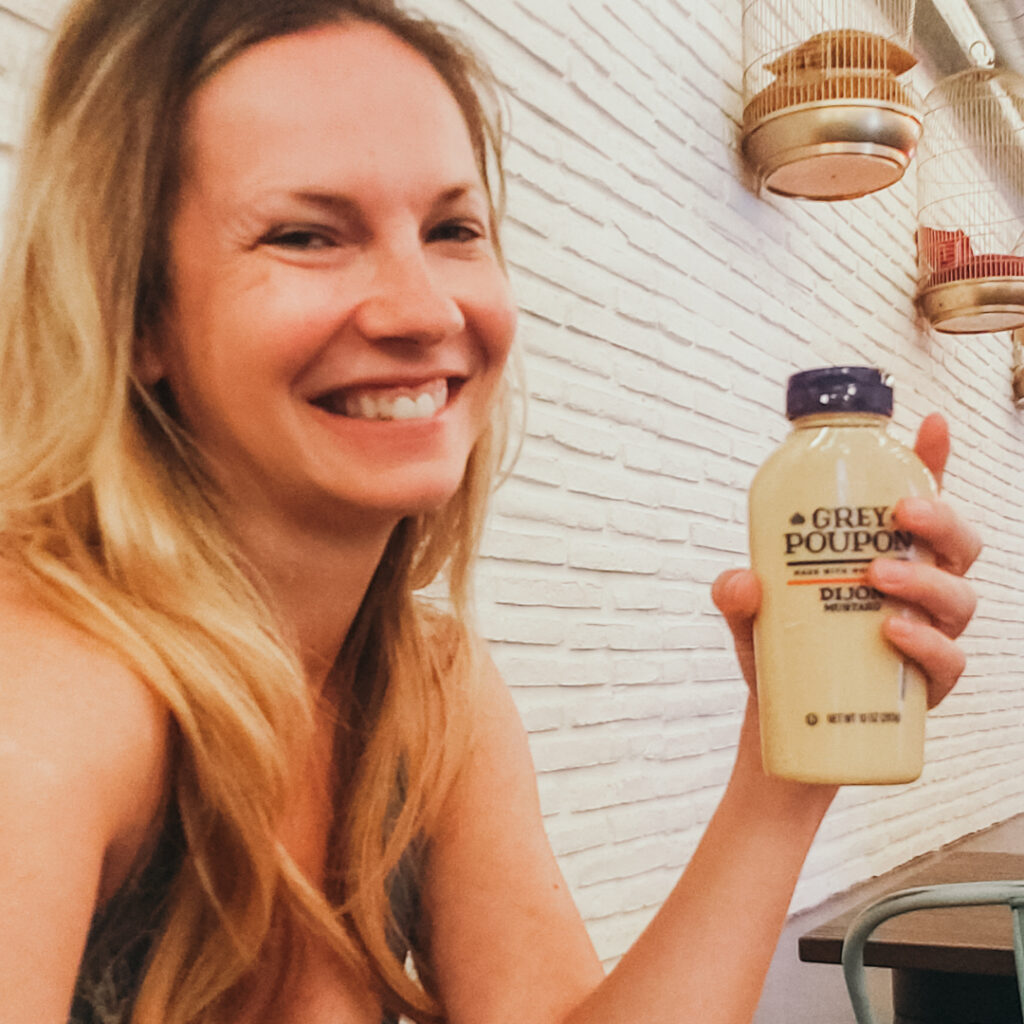
Camino costs and how to save
If you are thinking: “My goodness! I need to buy a whole lot of gear!” I sympathize. Your gear is the most expensive part of the Camino, except, perhaps, any international travel to get to Spain.
Consider browsing used-gear sites. This could save you some cash, and it’s a sustainable way to shop, too.
I love GearTrade, where you can buy gently used gear. Or even sell your gently used items!
REI also has a used gear catalog and members can trade in gently used gear for REI gift cards!
This post will help you find affordable hiking clothes and gear.
I’ve also created a Camino Cost Calculator so that you can determine your costs depending on your route and walking style.
All of the above resources are included in these printable Camino de Santiago packing lists:
Additional Camino Resources
02
Accommodations: When we didn’t stay in an albergue, we used the Booking.com app to find hotels
03
Travel Insurance: I used World Nomads
04
My Audible membership allowed me to listen to audible books while walking
05
Search for used outdoor gear at GearTrade
06
My Camino Resource Guide has everything you need, including this essential hiking survival kit for your backpack.
Did I forget something? Was there a crucial item that you couldn’t live without on the Camino or another trekking adventure? Did something on my list surprise you? Comment below and let me know!
About the Author
Hi! I’m Jen!
I’m a freelance writer and travel blogger who quit my nine-to-five after my fiancé, Jeff, died of cancer at the age of 40. When he died, I realized that life is just too short to delay our dreams. Since my dream was to travel and write, I now travel and write full-time. Today I wear hiking boots instead of heels and collect experiences instead of things.
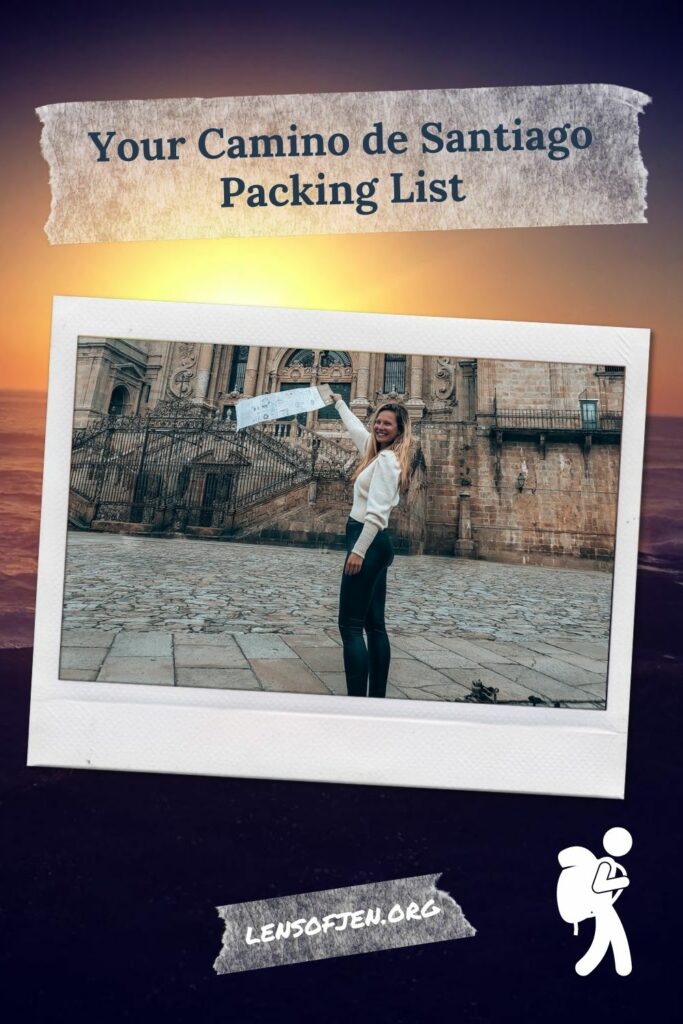



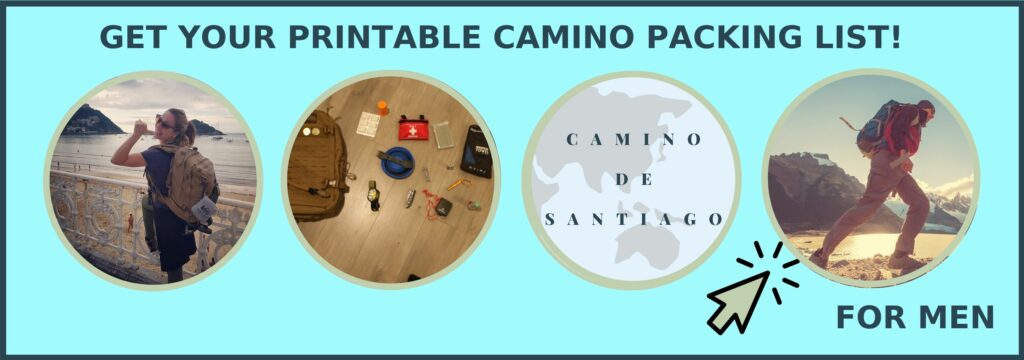

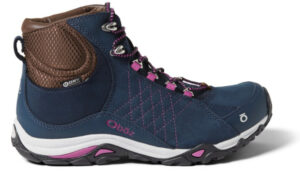



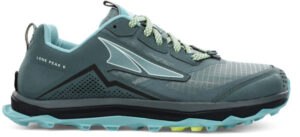






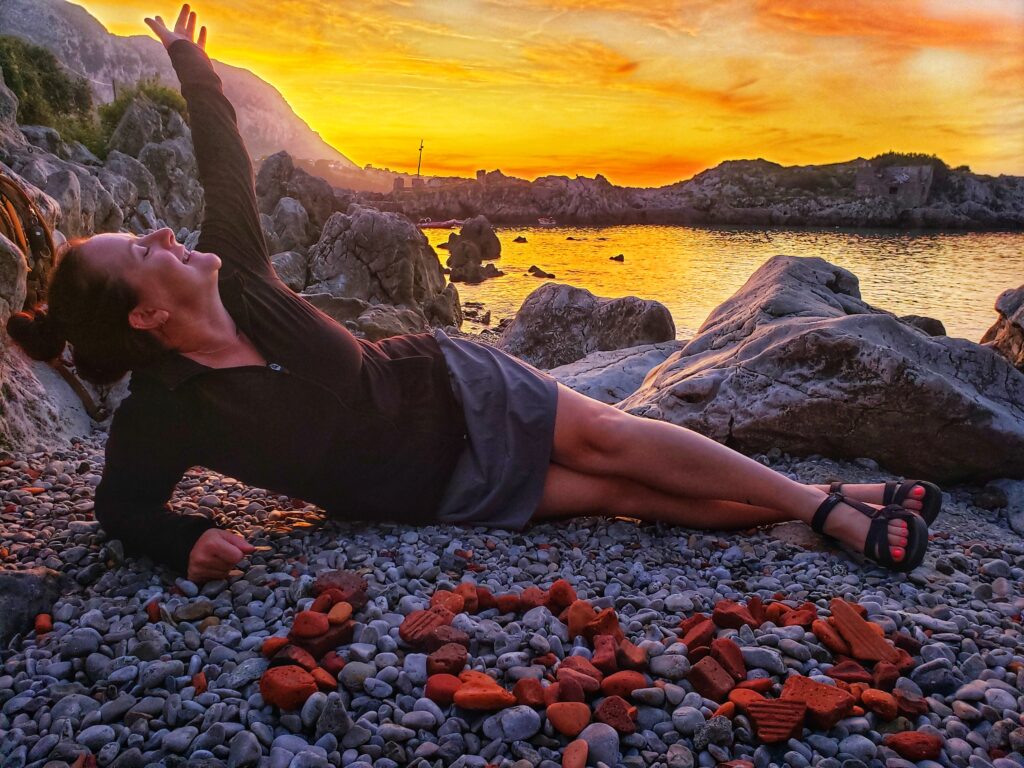



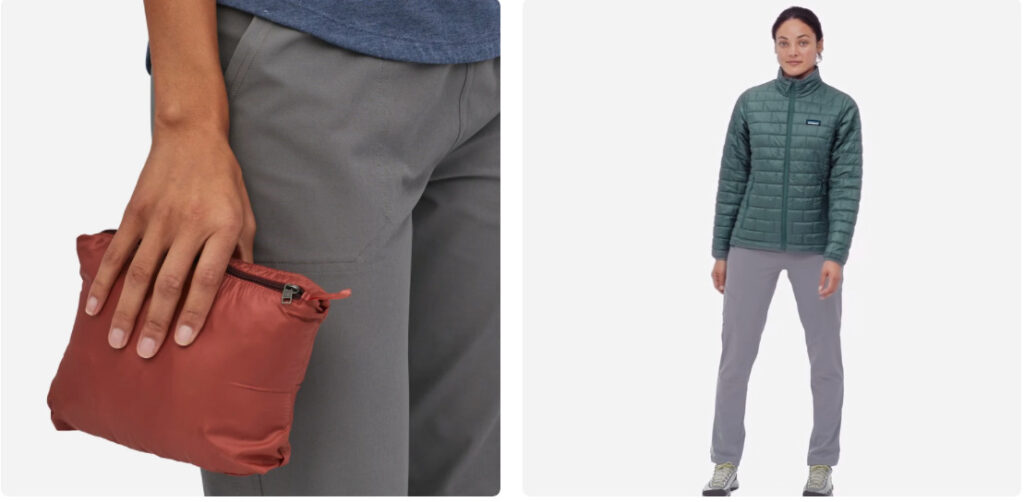
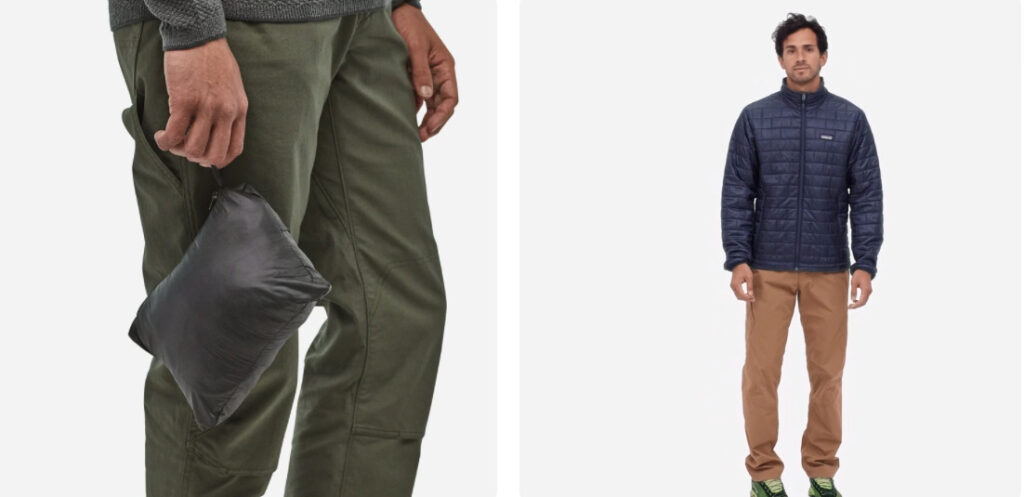













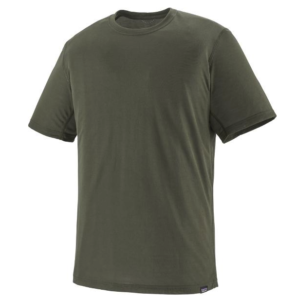




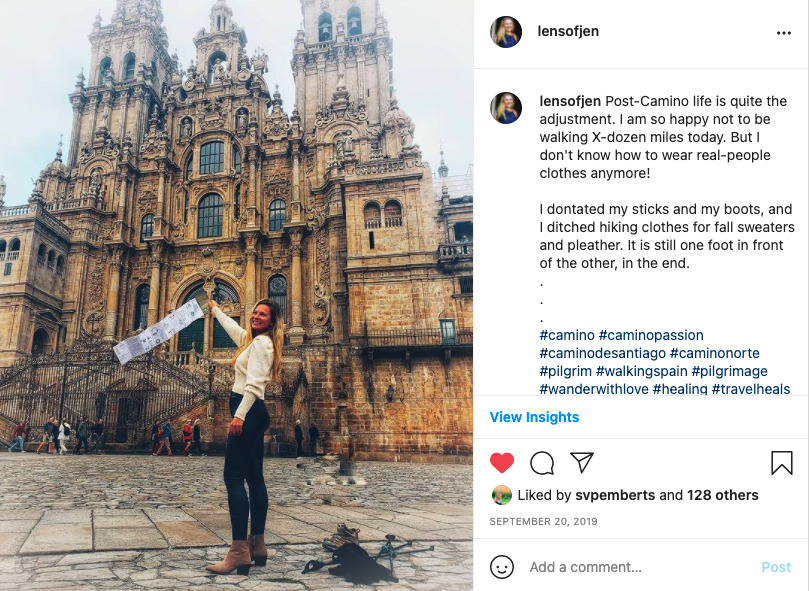
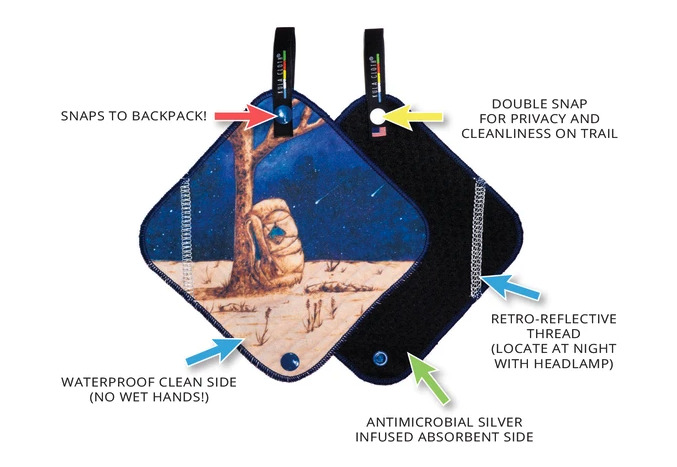



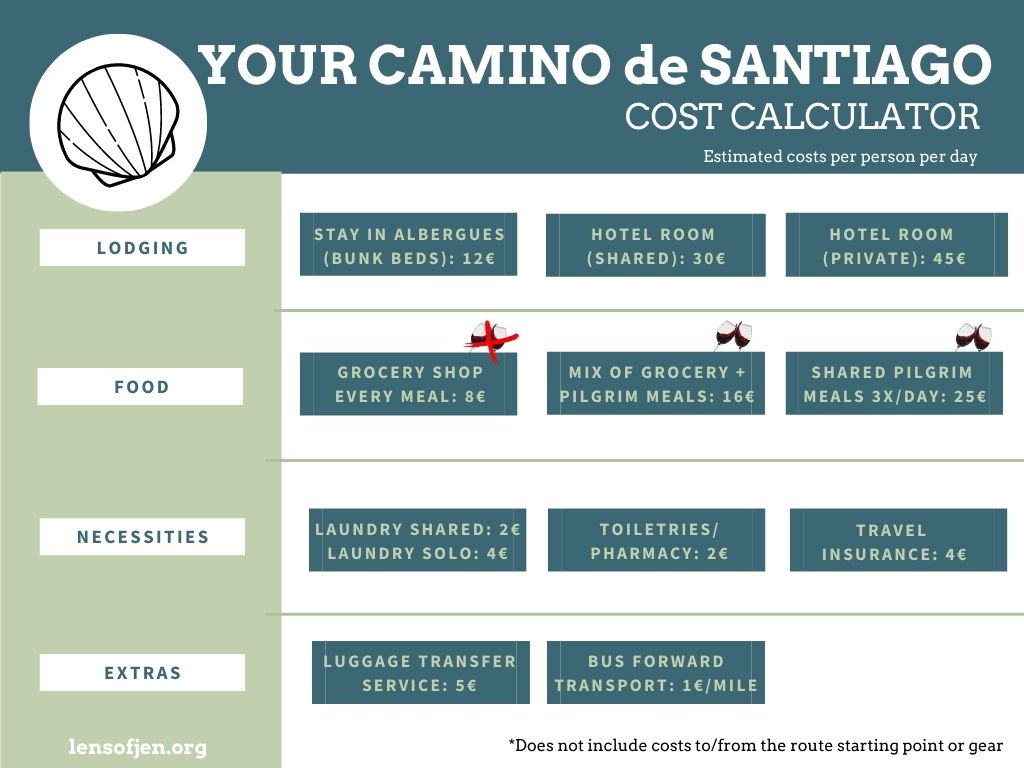
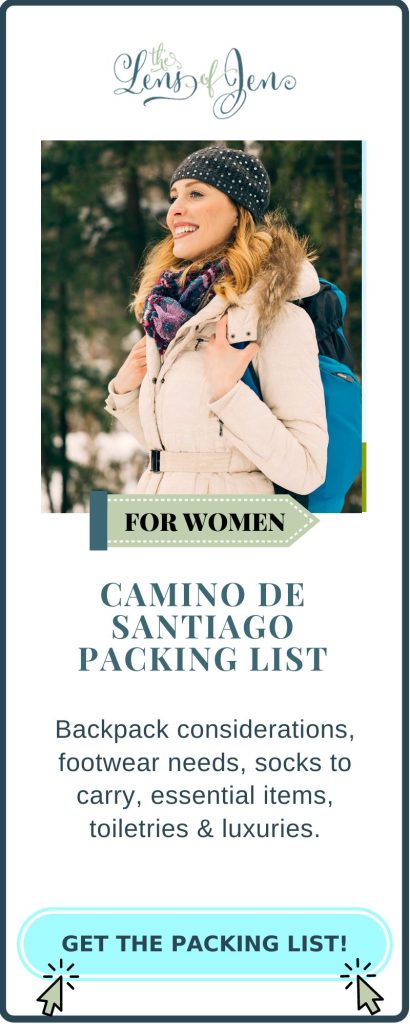
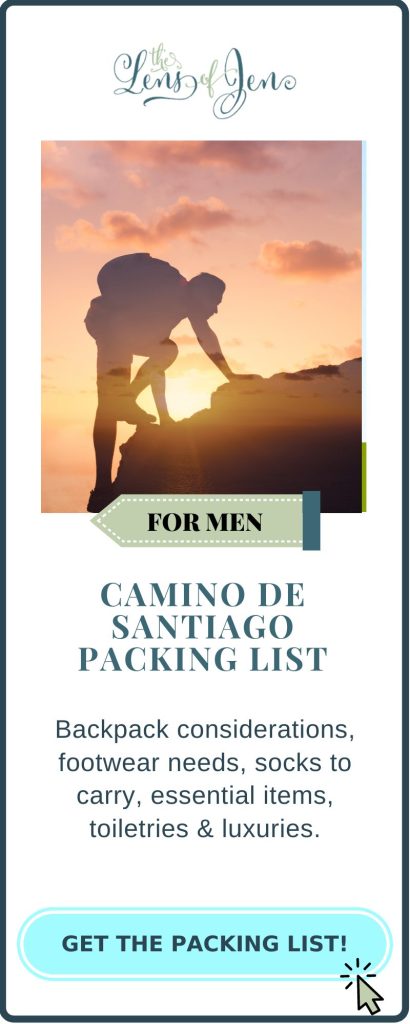
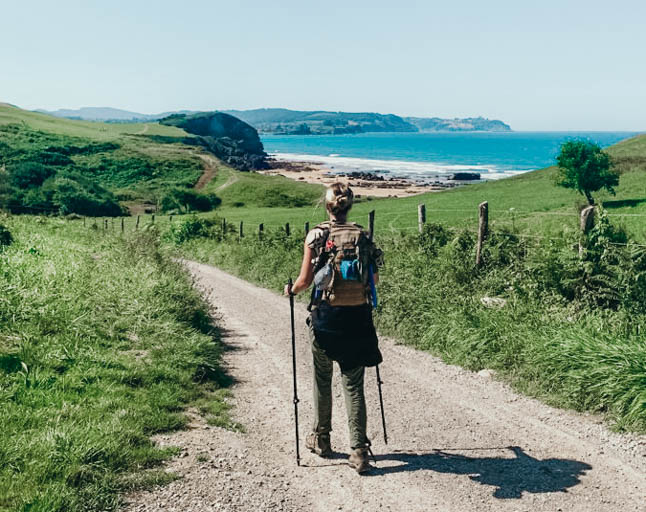
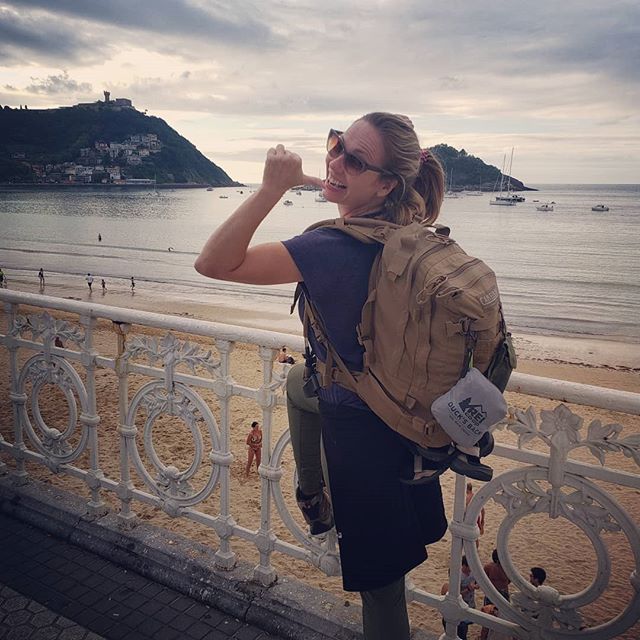
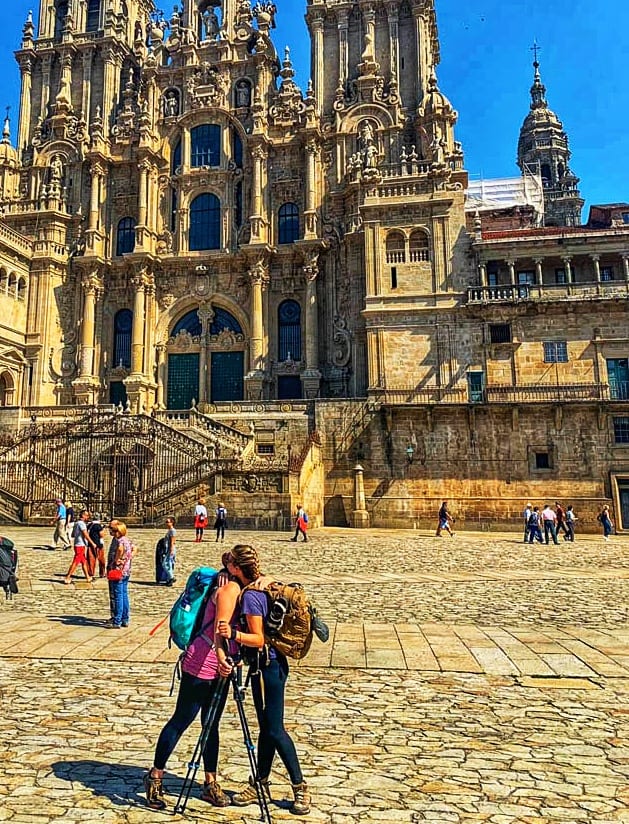
the road of santiago passes through pamplona where i live.
After 2 times cancelling, i made it to Sarria to meet my husband as he started in Pied de Port. I had read your blog and found the info really helpful. I had the trail shoes but it rained so I wore my Merrells the whole time. Since I had already bought my pack, I choose to bring it even though I knew it felt off. It was too big at 36, so i sent it ahead and bought a day pack. I’m heading back to walk the Coastal route from Porto and I’m taking the Deuter 28 pack and packing light. Thanks again for the great advice.
So glad you were able to make the trip! The shoes are so hard to choose, right?! I really am going to walk with two pairs next time. I started with just one pair on my second trip and immediately regretted it. My feet just need to switch shoes if I’m going to avoid blisters. Sending your backpack ahead is such a good option. My mom is walking this summer and that is exactly how she is going to do it. Glad you found the advice helpful!
Hi Jen, My wife and I are planning to walk El Camino Frances in the Spring of 2023. You wrote your friend joined you halfway through your pilgrimage and she brought stickers that read: “no vino…no Camino”. Do you have any idea where she got these stickers? I love the idea of giving them to fellow pilgrims along the way. Thanks and your website is very informative!
Dave
She made the stickers herself – though she may have had some help from an artist on Etsy (if I remember correctly). I’m so glad you found the Camino information helpful!
Overwhelmed with all your info and comments. Thank you. A friend has just asked me to go with her this next year. Both over 70. in Good shape and to do just 2 weeks. But my question is why was it a ‘ life changing adventure’.?
Wow, that’s a big question! The first time that I walked it put everything into perspective for me. The answers to the big life questions that I had seemed SO simple when I was out there walking. Things were just simplified. It seemed obvious to me that I shouldn’t go back to my previous life. So I didn’t! I doubled down on my own business and brand and I’ve been my own boss since that first pilgrimage. On my second pilgrimage, I fell in love with a fellow pilgrim. Shortly afterward, I moved to France with him. We now have a little baby boy!
Thanks Jen for all the work you put into this blog. I was intending to adapt my cycle touring gear (Istanbul to Luxor etc) but hadn’t given a thought to shoes!
A few questions:-
. Is it correct to address you as the sock queen?
. Do you have an idea of the weight you were carrying? (leave out the oranges of course)
. What is your opinion on the hiking trolleys?
. Is it hard to sleep out/camp on the Camino?
Kind regards Andrew
Hi Andrew! I love these questions.
1. I am now adopting the title of “Jen, Queen of Socks”. 🙂
2. I think I had about 20 pounds on my back. (I did stop to weigh my bag on my second pilgrimage, and I have the video footage somewhere. I will add it to this blog post as I’m about to update the post and packing list.) One thing I can say, for sure, is the less weight that you have the happier you will be. On my second pilgrimage, I walked from Santiago to Finistere and took almost nothing in my backpack. I was skipping all along the trail! That was eye opening. I will walk with less stuff next time…though always with oranges.
3. I’m not sure what the hiking trolleys are.
4. A know that a lot of people camp on the Camino, but I do think there might be some challenges in finding legal places.
Hi Jen!
I’m planning on doing the Norte this August & September. I was just going to pack bike shorts and tank tops, assuming it would be hot and humid, but now I know to pack some pants as well! Along with my packable puff jacket! Thank you very much for all of the detailed information you have provided here – it has been a TREMENDOUS help!!!! I plan on purchasing the Kula cloth! Thank you for introducing me to that!
One question I do have – was it easy to find a bed at municipal albergues where we can’t make reservations?
Thank you again for an amazing list, as well as great storytelling blogs.
Happy trails!
Krishna.
You are welcome, Krishna! I’m so glad my posts are helping you.
It was mostly easy to find a bed at albergues. The first part of the Norte was busy with tourists (San Sabastian to somewhere around Bilbao), so we did make advanced reservations in the first stretch. After that it was OK. If you are set on only municipal albergues (cheaper…donations to like ten euros) rather than privately run (up to 20 euros), then you’ll want to “bed race”. Meaning you’ll want to get up before everyone else and beat them there. If you are OK to wing it with slightly more expensive lodging, then you’ll probably be fine.
We had only one serious issue with housing and that was in Deba (stage 3). If you plan to stay there, make sure you book in advance.
Buen Camino, my friend! Please send me pictures along your pilgrimage!
-Jen
Hi, great info. I need to know how to get the train from Madrid to Saint Jean Pied de Port? or if it’s better to go from Barcelona to Saint Jean Pied de Port?
Thanks,
Hi, Maria,
Your timing is really good because I just sorted out my own travel to Saint Jean Pied de Port. I’m coming from southern Spain and opted to book a flight from Seville to Bilbao. Then I’ll take a bus or a train to either Irun-Hendaya or Bayonne. From there a rain to SJPDP.
Coming from Madrid or Barcelona is probably about the same in terms of ease. You’ll need to choose between a plane or train and you will probably choose Pamplona as your gate of entry. From Pamplona, you can take a bus to SJPDP or even a shared taxi. There are companies that organize shared rides with pilgrims from the airport or train station.
Hi there Jen 🙂
Great explanation as to why one should pack XX for the camino, however, I walked Camino France 3 times and Via de la Plata one time and I really think you should add sleeping bag to a must.
I literally do not remember many if any Albergues where you get blankets and sheets – and even if they were provided for me, I would NEVER wrap myself in anything that hundreds of others also use each night = dirt, sweat and bedbugs.
Sheets might be washed between each pilgrim stay but the blankets most definitly wont be.
I used my sleeping bag every night on the Albergues and I’m very VERY suprised that you managede to walk an entire camino not needing a sleeping bag.
I never needed a tent on Camino France, but on Via de la Plata it would have been great, as I one day had to walk 72 km to get to a place to stay, as two Albergues in a very remote area were closed (for good) despite my hiking list/map was updated 1 month prior by another pilgrim.
I’m off on my 4th Camino (France) next week. Buen Camino to everyone.
Buen Camino indeed! Four Caminos…so impressive! My walking partner and I are doing another pilgrimage this summer!
The silk sleeping sack listed is the answer to a sleeping bag when walking in the summer months. It’s lightweight and protects you from the germs and possible bed bugs. We never needed more than that (though I did spend one night very cold with all of my clothes on!)
Good point that I should make it more clear that this is for summer and maybe I’ll mention that we were lucky to not need a sleeping bag? I don’t intend to bring one on my next pilgrimage either, but I’m walking again in the summer. And, it’s probably important to note, that if I don’t get into an albergue for some reason, I’ll spring for a hotel rather than sleeping outside.
Buen Camino, my friend
This is the best Camino packing list I have read and I have read a ton throughout the pandemic. Great info, great writing style. Thank you!
Oh, that gives me so much joy! Thank you, Nadia. I hope it helps you with your journey. Buen Camino!
Amazing.
Your blog and everybody’s comments.
Wish mankind could learn from you guys!
Ricardo
Thank you! Buen Camino!
Wow! This is so impressive – the hiking and the packing! I am such a novice day hiker that I didn’t know you could be fitted for backpacks, but that makes sense! Thanks for sharing your story!
Thanks for reading! I didn’t know that you could be fitted for backpacks either. And I sure learned that lesson the hard way! I hope to save you the hassle (and pain) when you decide to do your pilgrimage!
Aneesahmad73072@gmail.com
Brilliant work Jen. I’ve been reading this for an hour cause you keep sending me off to check products that I’m sure I need. This is such an exhaustive list. You really did do the ultimate packing list, true to your word.
Thank you, John. That means so much to me. You are the master of comprehensive lists, so I am honored!
Wow! I had no idea it took this much pre-planning to do the Camino! I’m usually detailed when it comes to planning a trip, but you hit on several things I didn’t think about for a 35-day hike! Great post! I’ll be saving for this later when we make plans again for our Camino!
I can’t wait to read about your pilgrimage!
Wow. This is a complete packing list and I don’t think you have left anything off. I believe you can trust this list since it’s created from experience!
Ever since I heard of this trail through a local Spaniard friend I have been wanting to take this spiritual trip! I just lived vicariously through you on this. Amazing!
I hope you do it! It will change your life!
What a beautiful place! And such a comprehensive list! Thanks, babe!
This is such a useful guide for anyone thinking of hiking the Camino de Santiago. I know that I’d make all of the rookie mistakes you did and probably more! I like how you not only recommended products in this article but also told us where you (and friends) went wrong and how you learned from it. Very helpful!
Love it! I admire your dedication to doing the whole thing. Not gonna lie, it’s not something I would ever do, but, I loved reading about it. I think your tips can apply to many other hiking situations too and are very useful. As someone who suffers from back issues, I can totally relate to your family of muscle knots. Not pleasant!
The Camino is definitely not for everyone. But thank you for reading about it anyway! These tips definitely apply to other long-distance treks.
What a great share! This is so high on our bucket list. We had actually planned to do this in 2020. I hope we can reschedule for the future. I loved reading all your tips and tricks along with what gear to bring. I have a pair of Oboz and LOVE them!!
Oh, I hope you can schedule your pilgrimage again. I’m really really hoping for you. It’s a life changer.
This information would make any hiking adventure more comfortable. I have never put that much thought into my socks or even a backpack before. I’m saving this for my next hike!
I hope it helps!
What a great list to share! Those are really good points about needing different types of shoes. And I can only imagine how many socks you’ve gone thru!
So. Many. Socks! Thank you for reading.
How very kind of you to share a detailed list and quite an extensive guide to anyone who plans of taking a demanding challenge requiring both mental and physical stamina at the same time allowing oneself to let go and embrace life’s revelations in every step of the way.
I hope it helps! Thank you for reading!
What a great post not only for that specific pilgrimage but also a great review of gear that worked and some that didn’t and why. Gonna keep this handy for when I purchase gear in the future.
It’s always good to know about the gear that sucked. 🙂 Thanks for reading!
it is love
You weren’t wrong this is the best list indeed. All you need to on this. A few things I would never of thought of nor did I know of.
Not something I have heard about but will save this list and research a bit more
This is brilliant! I’m planning my Camino at the moment (I should have been setting off at the end of this month) and thought I was organised but there’s stuff on here I’d never have even considered! Thank you!!!
Man, we all owe you a debt of gratitude for this blog. It’s great not just for Camino travels but also any long distance hiking.
Thank you so much! I hope it will help someone pack that bag and take off for the first time!
That is such a handy and well put together list! I assume it’s good for most multi day hikes – especially in similar climatic conditions. I’ll save this this for my first multi day hike, which I’m gonna do ASAP, hopefully this year!
Yes, this list will absolutely work for a multi-day hike in which you don’t plan to camp. I am going to put together another list that adds tents + sleeping bags. But that’s a whole different kind of backpack. Thanks so much for checking out my list!
What an incredible packing list, for any long distance walk; really! And only 20L? It makes sense that you couldn’t even cram an orange in.
These are great tips and learnings for any long distance walking!
Yeah, I would definitely do a bigger bag next time. I needed those oranges on the trail! Thanks for reading, Lannie!
Wow I didn’t even think that getting a fitted backpack would make a difference, I always thought a backpack was just a backpack ? Felt like you just saved my life the next time I plan for a long trek!
I thought the same thing! And, oh, how I regretted it!
First of all, this guide/list is incredible. I know how long my posts that are like this one take, but with all the videos and graphics you have… wow. Second, I don’t even plan to be on the Camino for years, but there’s just something about your writing that keeps me reading and reading! I love the personal stories and speaking from experience.
Thank you so much, MacKenzie! I appreciate you reading this little tale of mine even though the Camino might not be in your near future. That being said…you never know when the Camino will call!
What a comprehensive list! Great tips.
Thank you! I hope it helps!
This is an epic resource for a most excellent adventure. One day, we’d love to do it. COVID ruined any immediate plans and we may have to put it off for many years now, unfortunately.
Stupid COVID. Yes, I know it may be a while before this list comes in handy. I’m hoping to do the Camino again next summer. Fingers crossed!
I love this post! There’s probably little chance of me walking the entire Camino de Santiago, BUT I’m still holding onto hope that I will walk some of it one day. This is such a great, comprehensive packing list. And to be honest, I’m totally going to buy a couple of these things for my hiking trips in California, so thank you!
These items will definitely help for your California hikes! Now that I’ve made the mistakes on the Camino, I get all kinds of prepared for even my short hikes. And I enjoy them all so much more now! Here’s to hoping that you’ll walk the Camino soon. (Even walking the last 100 kilometers is such a great experience.)
There are so many things to know before walking this route! It’s actually been on my bucket list for a while now but I haven’t managed to plan it yet. So thanks for the helpful tips and packing list!
I hope this helps to move the Camino to the top of your bucket list!
Okay this is definitely the BEST Camino packing guide I’ve read! Thank you so much for the detailed information, it will be so useful.
Thank you! That means so much to me! It took forever to get it all in one post!
What an incredibly thorough Camino guide. I have a friend who also did the walk a few years back, and she recommended many of the same things you did — even down to the toe sock liners. If anyone asks for Camino de Santiago info, I’m 100% forwarding this blog to them.
The socks are everything! Thanks for forwarding this along to people.
WOW!! You’re right. This is the best Camino packing list ever. It must have taken hours of work to share your experience and recommendations. Plus, you’ve introduced me to new products … pee cloth? They sound perfect. Thank you for this. It’s excellent.
It DID take hours of work! Thank you so much for noticing. Honestly. You just made my whole day. And the pee cloth will change your life for the better. Promise.